
edible ® Ojai & Ventura County CELEBRATING LOCAL FOOD & DRINK, SEASON BY SEASON Featuring our Shop Local Gift Guide
OF EDIBLE COMMUNITIES ISSUE 83 • WINTER 2022/23
MEMBER





@ TIERRASUR805 TIERRASURATHERZOG.COM 805 | 983 | 1560








WINTER 2 EdibleVenturaCounty.com


































































2 WINTER 2022/23
Ojai & Ventura County
Edible



REGULARS 6 PUBLISHER’S POST 16 TASTES LIKE WINTER 47 FORAGING FINDS 50 FARMERS’ MARKETS 60 DINING GUIDE 64 LAST SIP CONTENTS WINTER 2022/23 FEATURES 8 EDIBLE NOTABLES Angry Ferret Brewing | Onyx Bistro Nectar of the Dogs Wine | The Fisherman’s Wife 26 HOLIDAY GIFT GUIDE 30 IN THE FIELD Building a Better Cover Crop BY JENNIFER RICHARDSON 36 EDIBLE EXCERPT Apricot Lane Farms Cookbook 39 YOUNG VOICES From Italy to Ventura County BY AVERY LIEB 54 SUSTAINABLE LIVING Hot Tips for the Cool Season BY CAMILA GUZMAN 56 GROW WITH IT How Dry It Is BY SUZANNE LUCE 63 COCKTAIL HOUR Bitter About Cocktails? BY JOHN NICHOLS RECIPES 18 Walnut Pâté 20 Walnut Miso Salad with Seasonal Fruit 22 Roasted Winter Squash Soup with Walnut Cream 24 Walnut Truffles 37 Shepherd’s Pie 42 Pizza with Dry Farmed Tomatoes 44 Seasonal Winter Salad 53 Tuscan White Beans 64 The Ventura Sunflower COVER Simple in its elegance, this drink was the talk of town this fall when it took first place in the Taste of Local Mixology Throwdown. See what the fuss is all about on page 64. Photo by Viktor Budnik. ON THIS PAGE Collecting wild mustard seeds this winter is one way to help curb the proliferation of this invasive species. Learn more on page 47. Photo by Jess Starwood. 4 WINTER 2022/23
Edible Ojai & Ventura County
Inspired by the bounty of the Oxnard Plain and its pristine coastal waters, Ox & Ocean offers refined cuisine and unique craft cocktails in true So-Cal fashion. From a poolside breakfast or coastal lunch by day to an elevated dinner experience by night, Ox & Ocean is an evolutionary dining destination that marries land, sea, and libations in the unmatched setting of Zachari Dunes on Mandalay Beach Scan




WINTER 2022/23 5 EdibleVenturaCounty.com 2101
Beach Road | Oxnard,
| (805) 984-2500 Call now for reservations or visit us on OpenTable
Mandalay
CA
here
®
Winter seemed to arrive a bit suddenly this November, as it tends to in our region. One day it is unseasonably warm and the next we have potential frost in the dark hours of morning. How long it will stick always remains to be seen.
Like many in parched, drought-ridden areas, I have a deep love for rain and the “gloomy” weather that accompanies it. It is exciting to watch the clouds roll in, and enlivening—on those rare days—to see those clouds release their precious moisture for the thirsty land to drink. Clouds are not shrouds of darkness here, nor will a sunless sky ever feel morose to me.
Rather, winter here is a time of hope and reflection. With each scarce storm, I cast my gaze to the future, hoping that maybe this one will be enough of a soaking, that there will be more to follow. I reflect on the changes we have made and the many more needed to be made to live well in this arid place. I hold on to that hope for our farmers and food producers, even those just trying to live off their own land, and reflect on the perseverance and resilience it takes to continue in those fields.
I’ve been thinking a lot lately about the role that Edible plays in our local communities, especially as we head into that momentary quiet that comes with the winter season:
Are we here to keep you informed about cool places doing good food? Absolutely. Along with our curated advertising partners, check out the stories about a restaurant in TO doing the freshest fish (page 14), a chef who is making a mark in Camarillo (page 10), the very first wine tasting room in Simi Valley (page 12) and a hidden microbrewery in Moorpark (page 8).
Are we here to elevate new voices? I think so. See what teen foodie Avery Lieb learned on location in Tuscany this summer (page 40).
Are we here to support regenerative innovation in food production? As much as possible! Learn how you can support Rodale Institute’s research into new farming practices on the West Coast on page 30.
But mostly, I think we are here to inspire and build. Food is the common ground that connects us all. It can simultaneously be both a deeply pleasurable pursuit and an immense frustration: both political and apolitical, both gourmet and rustic, both a privilege and an essential need. It is my hope that each time you pick up this or any of our sister Edible magazines, you find inspiration that makes the journey of food a little more accessible, the connection to the food community a little more palpable and a clear understanding of your ability to build a better food world—rain or not.
Here is to many more years of Edible to come, and perhaps a rainier-than-average winter. Rain dance, anyone?
Ojai & Ventura County
PUBLISHER & EDITOR Tami Chu
COPY EDITOR
Doug Adrianson DESIGN Cheryl Angelina Koehler



CONTRIBUTORS
Nicole Facciuto • Camila Guzman
Robin Goldstein • Anne Kallas
Avery Lieb • Suzanne Luce John Nichols • Jennifer Richardson Jess Starwood
PHOTOGRAPHERS

Viktor Budnik • Tami Chu

Nicole Facciuto • Avery Lieb Mariah Green • Jess Starwood
ILLUSTRATORS
Ramiah Chu • Claudia Pardo
SALES Mary DiCesare mary@edibleventuracounty.com
SUBSCRIPTIONS
EdibleVenturaCounty.com info@edibleventuracounty.com
CONTACT US
Edible Ojai & Ventura County 2470 Stearns St. #142 Simi Valley, CA 93063 805-622-9355 info@edibleventuracounty.com
WE DELIVER!
Subscribe at EdibleVenturaCounty.com to have copies delivered right to your door.



Check out our website, subscribe to our newsletter and follow us on social media @EdibleVenturaCounty for up-to-date events, recipes and news from the food and drink community of Ventura County.
Founded 2002 by Tracey Ryder and Carole Topalian, Edible Ojai & Ventura County is published seasonally, four times a year. We are an advertising- and subscriber-supported publication, locally and independently owned and operated and a member of Edible Communities, Inc. Distribution is throughout Ventura County and by subscription for $28 per year. Every effort is made to avoid errors, misspellings and omissions. If, however, an error comes to your attention, please accept our sincere apologies and let us know.
6 WINTER 2022/23
&
County
Edible Ojai
Ventura
edible
PUBLISHER’S Post edible ® Ojai&VenturaCounty CELEBRATINGLOCALFOOD&DRINK,SEASONBYSEASON edible Ojai & Ventura County Ventura County Wine Guide Grow Food From Scraps Slow Food/Slow Wine MEMBEROFEDIBLECOMMUNITIES ISSUE83 WINTER2022/23 ISSUE 83 WINTER 2022/23

BEER WITH AN ANGRY FERRET
BY ANNE KALLAS | PHOTOS BY VIKTOR BUDNIK
Although ferrets (the rodents) may be energetic and challenging critters, at the Angry Ferret Brewing Company in Moorpark the atmosphere is chill, relaxed and fun.
Terry Baker, who co-owns the pub with wife Angel Baker, has been brewing beers as a hobby for 23 years.
“Both my wife and I are of English, Irish and Scottish descent, and we always liked those styles of beers,” says Terry, who originally worked in information technology. “In 2016, I had a midcareer change forced on me. I was looking around at everything and decided, ‘Ehhh, let’s take the plunge, get a business plan together and open our own brewery.’ Here we are.”
The couple carefully researched beers by making multiple trips to Europe to explore pubs.


“We focused on Irish/English beers and how they are different. For sampling styles, we traveled to Europe quite a bit. We tried local beers over there. I learned how it’s brewed pretty much the same as an IPA, and how it’s also close to Germans, who also have a few different recipes,” says Terry.


Both the simplicity and complexity of beer brewing have fueled Terry’s passion. “It’s just the number of varieties you can come up
with. There’re only four ingredients to beer. But with the grains that are available to us, we can mix things from very light flavored to very dark heavy flavors, by mixing the different flavors.”
In May 2021, Terry and Angel opened the Angry Ferret Brewing Company pub at 11990 Hertz Ave., Moorpark. Terry says the name came about because they used to raise ferrets as pets. “When it came time to name the business, we were sitting around and that popped up and it just kind of stuck,” says Terry.

Terry brews his small-batch beers in back, while Angel brings fun and games to the front of the pub, which is decorated with dark furniture that encourages communal seating.
“It’s a standard pub where you come to enjoy yourself, where you’ll find people you never would have spoken to,” says Angel. “We don’t have TVs. We promote people actually talking to each other and enjoying each other’s company. I’m kind of an outgoing person so often I’ll start the conversation.”
Besides a foosball table, there are two steel-tip dartboards available, and Angel says she’s trying to start a team for league play. There are also trivia nights and board game nights, as well as entertainment on weekends.
EDIBLE Notables
For the winter months, Angel says she hopes to introduce a new seasonal concept drink. “I’d like to try to experiment with a milk stout and make it into a hot chocolate,” she says.



Terry says that he uses a small brewing system that makes limited amounts of ale, which affords him flexibility. “I’ve got a three-barrel system that makes 100 gallons per batch. Compared with other breweries that’s tiny,” says Terry, adding that other brewmasters at larger places in town have been very helpful. “All of the local breweries are good. But I can play around a bit more because I’m not [at risk of] ruining a big batch. Because I’m new at this, I’m always concentrating on getting everything right. It’s all about the product at the end.”






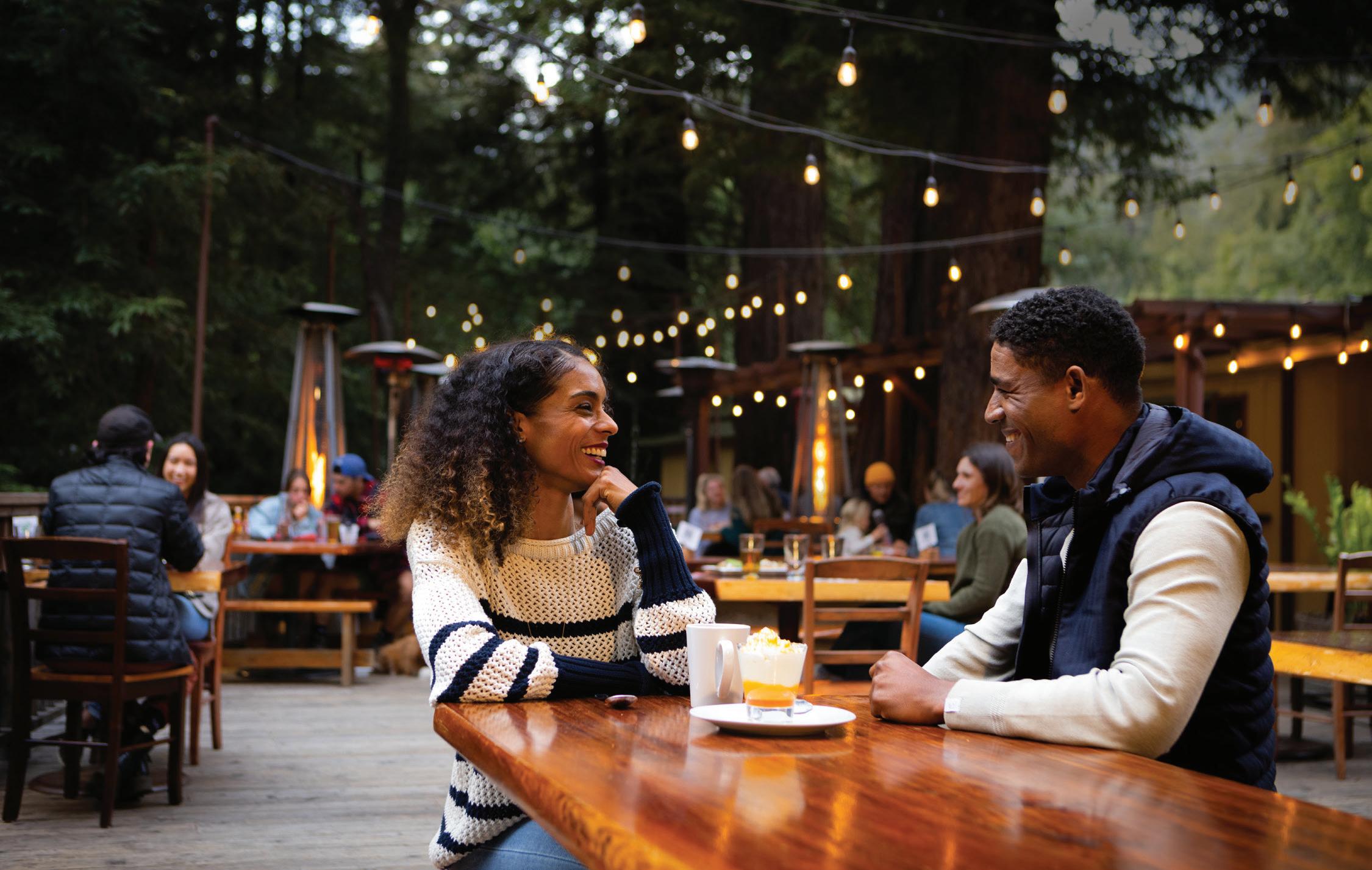

The pub doesn’t offer food, but during weekends various food trucks come and offer noshes to go with the ale.
Terry says the reception from the community has been warm. “All of the people who’ve been in here liked the beer and the atmosphere,” he says. “We’re still in the stage of getting the word out. But once [people] get in, they like it.”
For more information visit AngryFerretBrewing.com/wp or call 805-209-5963.
WINTER 2022/23 9 EdibleVenturaCounty.com
Anne Kallas is a prolific freelance writer focusing on Ventura County. A fan of local, seasonal produce, she lives in Ventura and is a former columnist, writer and copy editor for the Ventura County Star
LEAVING THE RELM WITH ONYX BISTRO
BY ANNE KALLAS | PHOTOS BY VIKTOR BUDNIK
From a mélange of cuisines to a carefully selected complementa ry array of wines and beers, Danielle Saleh brings her passion for food and drink to the table at Onyx Bistro in Camarillo.


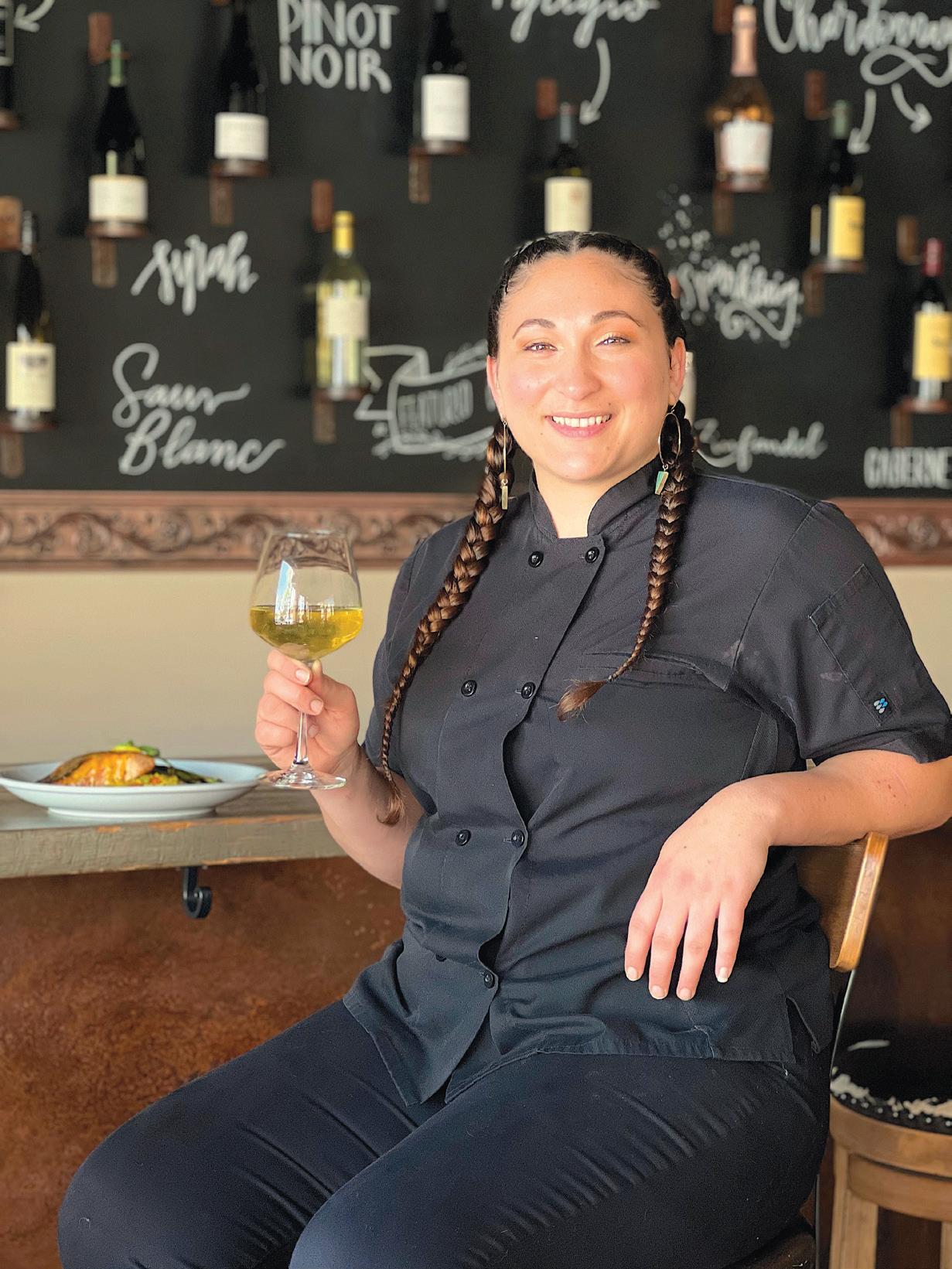
“A lot of my food is considered fusion—from Asian to Middle Eastern flavors. They’re things I enjoy. I wanted to bring flavors to the table that not a lot of people see in this area,” says Saleh. Her menu also features fun favorites like barbecued beef brisket and grilled salmon.
Growing up, Saleh spent a lot of time at her family’s shop, Front Street Cuisine & Catering in Ventura. Both parents are originally from Egypt, and both have culinary backgrounds.
“I was introduced to a lot of flavors at a young age. Egyptian food has so many flavors—Greek and Lebanese, to name a few. I work with those flavors in the hummus, tabbouleh and falafel. I want to showcase Middle Eastern spices and flavors,” she says.
Last March, Saleh took over the former Relm Wine and Beer Bistro in Camarillo, which had been owned and run by Patrick and Valeri Mervyn. The venue features heated patios and live mu sic, as well as food and drink. Saleh had helped out in the kitchen of Relm from time to time, in addition to operating her thriving catering career.
“The owners have been like family. They sat me down and said, ‘This is what we’re thinking. We don’t want to sell this business to just anybody,’” Saleh recalls. “It was a hollow building—just a shell until they built it out. It’s stunning. Everything happens for a reason and it felt like a good fit. I was outgrowing my catering business. My commercial kitchen was too small.”
Saleh is being joined by her partner Will Smith-Wruck. (No, not THAT Will Smith; I asked.) The two met years ago in Humboldt
10 WINTER 2022/23 Edible Ojai & Ventura County
EDIBLE Notables
2390 Las Posas Rd., Suite H, in Camarillo Village Square 805-991-7356

OnyxBistroCamarillo.com
County, where they both worked at Luke’s Joint in Arcata. They share a love of food, as well as each other.
“The biggest thing that her restaurant brings to the local wine community is new pairings with regular casual dining,” says Smith-Wruck, who acknowledges that while he specializes in beers, he’s had fun delving into the world of wines. “Her specific food style not in one lane at all. It takes a massive amount of consideration to make all of the pairings and choices really fun.”
“We are beer and wine only,” says Saleh. “We showcase a lot of local wineries and breweries. All of our beer is local and they rotate every month. Most of our wines are Central California–based. I like to support the readily available businesses.

“My two most important things with food are to try to go as local as possible and as fresh as possible and organic if possible. We are 60% to 70% organic when I can get it. I rotate the menu seasonally to showcase the best available produce during the best time.”
When Saleh took over the old bistro, she changed the name to Onyx. “I wanted to make it my own. To change the name and give it my own spin,” she says, putting her associate’s degree in business from Ventura College to good use.
“Onyx is a stone and I really enjoy stones. I have them all over the restaurant. Onyx is a chic black stone that has a lot of power and significance,” says Saleh. “I like how it makes me feel in connection to the earth—a groundedness and strength.”
WINTER 2022/23 11 EdibleVenturaCounty.com
Onyx Bistro
BY ANNE KALLAS | PHOTO BY MARIAH GREEN
If you’re the type of person who adores your dog and loves wine, Simi Valley’s first wine tasting room at Nectar of the Dogs Wine will definitely be your jam.
While dogs aren’t actually allowed at the tasting room per the City of Simi Valley, there will be plenty of pictures of puppies lining the walls and decorating the labels of the small-batch wine bottles, according to CEO/owner Melanie Garibay.






Nectar of the Dogs Wine is a boutique wine company that sources their wine from several small wineries up and down Califor nia, blends and bottles with a host winery in Camarillo and donates a portion of the profits to various dog rescue organizations.
“I love wine culture and the science of winemaking. The people I have met (and continue to meet) along my journey in the wine biz are some of the most interesting and kind people … really inspiring,” says Garibay, who has always been passionate about wine, learning as much as she could
while still working as an event producer. “In these crazy times we live in today, it’s the simple things—dogs and wine—that help me stay grounded.”
Alexandra Clingman, associate planner with Simi Valley Environmental Services Department, says there has been interest in allowing tasting rooms for breweries or win eries in Simi Valley, but the city didn’t have an ordinance that explicitly permitted them. So in 2019, the Simi Valley City Council re quested that city staff research and craft a new ordinance that would cover the businesses.
Having the first endeavor that was al lowed under the new ordinance be some thing as unusual as a dog-themed wine tasting room was especially gratifying for Clingman, who is an animal lover.
“This was the first project I got under the new ordinance. I was so excited to have it be a very unique kind of business,” says Clingman. “Working with Melanie, who is one of the most sweet, exciting persons, has
been great. She’s been super understanding of the process of updating the code. When she first approached us, we hadn’t finished updating the code. She was amazing, and patiently waited.”
The tasting room will be small and com fortable. “We’re in a smaller city industrial park, so we’re going for a warm rustic indus trial vibe. We want guests to find a little wine oasis in this part of Simi where they can come and sip for a cause with us,” says Garibay.
Husband Todd Sobleski will manage the organization in the back of the house, while Garibay will pour wines in the front. The tasting room will be open weekends only.
For more information and hours visit NectaroftheDogsWine.com.
12 WINTER 2022/23 Edible Ojai & Ventura County
EDIBLE Notables SIT! AND STAY! at Simi’s First Wine Tasting Room
A p o r t i o n o f a l n o n p r o f i t d o g g 791 Chambers Ln Suite 110, Simi Valley CA nectarofthedogswine com | 702 275 0482 Follow us on IG @nectarofthedogswine Mention this ad to receive 10% off 2 bottles or more Simi Valley's First Tasting Room


The Fisherman’s Wife Brings Local Fish to the Table
BY ANNE KALLAS | PHOTOS BY MARIAH GREEN
Imagine sitting down to a meal of fish that was actually swimming in the Pacific Ocean right off of the Ventura County coast the day before.
The grilled fish at The Fisherman’s Wife comes from real-life fisherman Chris Williams, who works off his 37foot boat, the F/V Linde, out of Channel Islands Harbor. It’s that fresh.

That fresh fish, which is served at The Fisherman’s Wife, is cooked with a minimum of embellishment.
“We wanted to make the seasonings simple so people could actually taste the flavor of the fish,” says Chef Yulian Navarro, who honed his fish cooking skills at Brophy Brothers Clam Bar and Restaurant. “When you try to do too much to the food, it doesn’t work adding a bunch of ingredients. I want the meal to star the fresh fish. We’re always working as simple as we can, and making sense with what we have.”
Depending on the haul from each day’s fishing means the menu has to be flexible, says Dania Williams, Chris’s wife, who is running the recently opened restaurant.
“We have to adjust. Luckily, we have this digital menu that we can change at will. My husband fishes yearround. But he can’t catch white sea bass all of the time. So when that slows down, there’s halibut. We have to be flexible,” says Dania.
The Williamses still sell their fish at the Channel Islands Farmers’ Market, just as they have for the past 13 years. It was at the market, where they sold under the banner Fresh Fish Fanatics, that they were introduced to a group of avid regular customers. Those customers kept them afloat during the COVID shutdowns, when Chris was unable to sell fish to area restaurants that were closed.
“It was such a weird thing. We look back on COVID as letting us get to know our customers who had support ed us for 13 years,” says Dania.
EDIBLE Notables
The Fisherman’s Wife 1610 Thousand Oaks Blvd. 805-371-5651 For the menu and more information, visit FishermansWife.com. 14 WINTER 2022/23
Edible Ojai & Ventura
County
The Williams family turned to home deliveries for income during the downturn. Dania and daughter Anna Grace, 17, would drive around making fish deliveries. Son Max, 22, has his own boat and is following dad as a commercial fisherman. Son Micah, 14, hasn’t shown much of an inclination to follow his father and brother to sea, Dania says, adding that her youngest child helps out at the restaurant.
“It was such a wonderful thing that came out of that scary time— the people who support each other in difficult times,” says Dania.
Assessing her customer base, with regular customers from Ventura to Agoura Hills, Dania decided that Thousand Oaks would be a great location. So far, after opening in August, she’s been proved right.
“The Thousand Oaks community has been so welcoming and so kind,” says Dania. “We’re so blown away by the support in this area.”

The menu at The Fisherman’s Wife, a moniker Dania earned over the years as she ran the business side of things, reflects more than just the freshness of the seafood.

“We aim to get most of our fish from my husband, though it is supplemented by other local fishermen. Outside of that, some of our fish come from Harbor Meat and Seafood in Santa Barbara. The fruits and vegetables are local from The Berry Man, who has such an awesome reputation,” says Dania.
Breads come from Agostino’s Bakery in Ventura, which is a lo cal family-run business. They also serve Ragamuffin Roasters coffee, which Dania declares “amazing.”
In addition to the fresh fish, customer service is a priority at the new restaurant. “Our main focus is to connect with people,” says Dania. “I constantly think about this. I want to make sure every per son walking through the door has been seen and cared for. It’s what brings me the most joy and purpose in this business.”
WINTER 2022/23 15 EdibleVenturaCounty.com
Want Walnuts? Get Fresh
With nuts, age makes all the difference
PHOTOS AND WORDS BY NICOLE FACCIUTO
Iadore walnuts. When people learn that I grew up on an or ganic walnut farm, the responses are always polarizing. People either love them or strongly dislike them and are often wary of this brain-shaped nut because of the flavor of the walnuts they are used to eating. If you’re accustomed to dry, bitter, unappealing walnuts, then you’ve probably been eating old nuts.
The flavor of walnuts has everything to do with seasonality and stor age. Think about any seasonal fruit or vegetable you’ve ever had, and I’m sure you can remember the moment you realized how incredibly different it tasted when it was at its peak of freshness. Most people don’t give this type of consideration to walnuts, though they should.
Seasonal walnuts enjoyed within their harvest year have a wildly different flavor profile than what many are familiar with. They’re soft, buttery and utterly delicious.
Being raised on a farm, I was always working—from pruning suckers off the trees to helping my dad prepare for harvest. There’s no better experience than picking a walnut straight off the tree, smash ing it against its trunk and enjoying it on the spot.
Unless you’ve had the good fortune of a walnut tree in your back yard or personally know a walnut farmer, acquiring a stash requires a bit of perseverance. An orchard’s bounty is typically harvested begin ning around the fall equinox, so it’s best to keep an eye out at your local farmers’ markets during the winter months. A simple Google search for “seasonal raw organic walnuts near me” will help you find
them. Trust me: The effort will be worth it, and your relationship with walnuts will completely transform.
I’m sure some of you can relate to the experience of biting into an old, rancid walnut. It’s no fun. Walnuts contain roughly 50–70% oil, depending on the variety, and when this delicate liquid sunshine goes bad, no amount of soaking or roasting will help them taste any better.
Always look for and inquire about the harvest date when pur chasing walnuts. We’re all familiar with expiration dates. However, that date won’t tell you how old the nuts are. The harvest date is a “must-know” when sourcing fresh walnuts that you can’t stop eating!
As someone with an abundance of fresh organic walnuts on hand, I’ve enjoyed them in every format imaginable: whole walnuts, walnut meal, walnut oil, walnut butter, walnut milk, pickled green walnuts and even a walnut liqueur. When added to chilis and curries, walnuts generate a lovely balance of tender flavor and crunchy goodness. On a whim I once added walnut cream to ramen broth, which completely transformed the dish. Believe it or not, walnut oil is an incredible ad dition to cocktails—a complete game changer. In their various forms, walnuts add an unexpected decadent touch to many dishes, and fresh ness is the key to their versatility.
It’s easy to enjoy this seasonal superfood in any creation you make. With some of the highest levels of antioxidants and omega-3 oils of any nut, these nutrient-dense gems will make a powerful addition to your culinary repertoire.

TASTES Like Winter
16 WINTER 2022/23 Edible Ojai & Ventura County
Nicole Facciuto is a California native and Food Network alumna whose background in organic walnut farming and mission to alter how people enjoy walnuts led her to found CORKY’S NUTS, an award-winning raw organic walnut company based in Ventura. Her new retail location is set to open in spring of 2023. CORKYSNUTS.com
Did you know?

Ojai Valley, San Fernando Valley and Heritage Valley were filled with walnut orchards before citrus groves were planted in favor of higher yields/income.
Walnut trees don’t need bees and are pollinated by air currents. Plus, they’re 100% vegan.


Walnuts should NEVER be stored in the pantry. Always keep them sealed in the fridge or freezer.








Walnuts are cholesterol-free, rich in polyphenols, magnesium and calcium—making them great for brain and heart health.
99% of walnuts grown in the United States are grown in California.



China is the largest producer of walnuts in the world. (Always look for the origin on the packaging.)
Best tip: Always look for, and inquire about the harvest year, not the expiration date.
WINTER 2022/23 17
Edible Summer Visit ParadisePantry.com for our always fresh daily specials. 805 641 9440 • 222 East Main Street • Ventura California 93001 Locally Sourced . Chef Inspired Seasonal Creations Vibrant Ambiance . Winemaker Events . Dinner Specials Wine Tasting . Artisan Market . Cheese + Charcuterie seasons are our specialty
Get Nutty About Walnuts
RECIPES AND PHOTOS
BY NICOLE FACCIUTO
Walnuts are a versatile ingredient that can be used in an abundance of dishes. The recipes shared here are vegetarian and made with simple, seasonal ingredients that allow their fresh flavor profile to shine. When a recipe calls for walnuts, the key to a delicious outcome is to source the freshest, in-season wal nuts possible to prevent old, rancid nuts from ruining your culinary creation.
Versatile Vegan Walnut Pâté
Watch out, dips of holiday past: There’s a new kid in town. We use fresh organic walnuts in almost everything we make, so adding this dip/pâté creation to our weekly snacking repertoire didn’t take long. As a versatile spread, it pairs beautifully with crudites and works wonders on a holiday-leftovers sandwich.

Makes about 2 cups
2 cups chopped walnuts
16 cloves raw organic garlic
½ cup water
¼ cup organic lemon juice (roughly 1 large lemon)
2 tablespoons nutritional yeast
2 tablespoons organic olive oil
1 tablespoon organic Bragg Liquid Aminos or organic tamari (soy sauce)
¼ teaspoon Himalayan sea salt ¼ teaspoon black pepper Chopped organic chives for garnish
This can be made in a blender or food processor. Combine all ingredients and blend to creamy or desired consistency. Less blending yields chunkier texture.
Serve on a plate or bowl and finish with a drizzle of olive oil and fresh herbs.
Chef Notes: Pairs well with a charcuterie board, sliced raw veggies, chips and crackers. Can also be used to top a quinoa bowl with fresh mixed greens and vegetables.
Alternatively, you can add ¼ cup of seasonal chopped fresh herbs; stir in after blending and before plating. Don’t have chives on hand? Sprinkle on red pepper flakes or a za’atar blend.
TASTES Like Winter

TASTES Like Winter
Walnut Miso Salad With Seasonal Fruit

I love using walnut oil for dressings. Its mild, buttery flavor makes anything paired with it shine. This salad and dressing pay tribute to sweet and umami flavor profiles and deliver a delicious, whimsical journey for your taste buds.
Serves 2 as a main dish, 4 as a side dish
For walnut miso dressing:
3 tablespoons cold-pressed organic walnut oil
2 tablespoons white wine vinegar
1 teaspoon white miso paste
1½ teaspoons maple syrup
Pinch of salt and pepper to taste
For salad:
1 Bartlett pear
8 ounces seasonal mixed greens
2–3 ounces plain goat cheese
½ cup raw organic walnuts, whole or chopped
Combine walnut oil, vinegar, miso, maple syrup, salt and pepper in vessel of your choosing. Either seal and shake, or mix with whisk/fork until blended.
Slice pear in half lengthwise, then slice into thin segments; set aside. Add mixed greens to a bowl and pour dressing over greens. Gently toss until greens are thoroughly coated. Transfer greens to serving bowl or platter. Add sliced pears to salad. Garnish with goat cheese and whole or chopped walnuts. Serve immediately.
Chef Note: The fruit element in this salad can be adjusted depending on the season: citrus in late winter, blueberries in the spring, strawberries in summer, pears or pomegranates in fall. Looking to add a protein element? Grilled chicken or shrimp would make a lovely addition.
20 WINTER 2022/23 Edible Ojai & Ventura County
What does it mean to be Educated?





oakgroveschool.org/edible
TASTES Like Winter
Roasted Winter Squash Soup
With Walnut Cream
This rich, creamy soup takes advantage of one of winter’s prolific edible bounties: squash. In all its various flavors and shapes, using this simple ingredient to warm you on a rare chilly California day will delight your palate with seasonal goodness.

Serves 6–8
1 large acorn squash
1 large delicata squash
Olive oil
1 large yellow onion
16 cloves garlic
3 cups vegetable broth
3 cups raw organic walnuts
3 cups water
Salt and pepper
Fresh herbs (sage, chives, etc.)
Preheat oven to 400°F.
Line baking sheet with parchment paper. Cut each squash in half, remove seeds, drizzle a little bit of olive oil on each slice, place face down on baking sheet; bake on middle rack of oven for 45 minutes, or until tender.
While squash is roasting, roughly chop yellow onion and garlic. Add onion and garlic to a saucepan with a drizzle of olive oil. Cook on medium heat until onion is translucent, being careful not to caramelize. Set aside.
Remove roasted squash when soft to touch; let cool. Scoop out acorn squash and place in blender.
For delicata squash, the peel is edible and gives a lovely color variance to soup. Cut delicata into smaller chunks and add to blender with acorn squash. Add 2 cups of vegetable broth and blend until smooth, adding more broth as needed until a smooth consistency is achieved. Once mixture is blended, place soup mixture in large saucepan or pot on the lowest heat setting.
Rinse blender in preparation for walnut cream.
For walnut cream:
Add walnuts, cooked onion and garlic and 3 cups of water to blender. Blend until creamy and smooth, roughly 2 minutes, depending on blender. Add salt and pepper to taste.
Portion out half of the mixture and set aside. Pour the remaining walnut cream mixture into saucepan with soup base. Stir to combine. Add salt and pepper to taste. Slightly increase temperature and warm soup to serving temperature. This step is only in preparation for serving, no additional cooking is needed. If soup begins to thicken, add a little more vegetable broth.
To serve, ladle soup into bowls and garnish with a dollop of walnut cream, salt/pepper and fresh herbs.
Chef Note: Don’t have vegetable broth on hand? A chicken or beef broth will also work.
22 WINTER 2022/23 Edible Ojai & Ventura County




WINTER 2022/23 23 EdibleVenturaCounty.com SEASONAL INGREDIENTS LOCALLY SOURCED WOOD FIRED 818.575.3044 TWO DOLE DRIVE WESTLAKE VILLAGE, CA | 91362 COINANDCANDOR.COM | @COINANDCANDOR
TASTES Like Winter
Walnut Truffles
These delightful truffles are easy to prepare days ahead of a gathering and the perfect not-too-sweet snack to have on hand when that sugar craving kicks in. Think of them as an elevated, healthy version of a peanut butter cup. With just the right amount of sweetness, balanced with a little sea salt and packed with antioxidants, they’ll disappear quickly and provide a nutritious end to any event.
Makes about 28 truffles
For the truffle mixture:
6 organic dates
3 cups organic walnuts, chopped
¾ teaspoon organic vanilla extract
½ teaspoon Himalayan sea salt ½ teaspoon organic coconut oil
For the chocolate coating:
1½ cup dark chocolate chips (We used Santa Barbara Chocolate, in Ventura.)
2 teaspoons organic coconut oil
Pinch of sea salt
Toothpicks
Sea salt flakes to garnish. Can also use crushed walnuts or shredded coconut.
For the truffle: Add dates to small bowl and pour over hot water. Let dates soak 10 minutes, until soft.
To food processor, add chopped walnuts, soaked dates, vanilla, salt and coconut oil. Blend for roughly 1 minute, until smooth. Smaller chunks of walnuts are OK. Be mindful of over-blending, as you run the risk of more oil released from walnuts, which will not set properly.
Once blended, add truffle mixture to a medium-sized bowl.
Line baking sheet with parchment paper. Using a teaspoon, portion out truffle mixture to make 1-inch balls. Roll mixture between hands and place each ball on lined baking sheet. Continue until all mixture is used.
Place truffles in freezer for 1 hour to set before beginning chocolate coating.
For chocolate coating: Add dark chocolate chips, coconut oil and a pinch of salt to a shallow heat-safe bowl using a double broiler method: Bring 2 cups of water to a boil in medium saucepan. Place bowl with chocolate atop saucepan to melt ingredients, stirring consistently with a spatula.
(Alternatively, add ingredients to a glass bowl and microwave for 10-second intervals until completely melted, stirring in between.)
After chocolate is melted, remove truffles from freezer.
Using a toothpick, pierce one truffle at the top to pick up. While holding, place
Chef Notes:
truffle in chocolate and use a spoon to thoroughly coat ball. Drizzle and shake off excess chocolate. Set the covered truffle back onto the parchment paper and use a second toothpick to gently hold the truffle down while you pull out the toothpick. A hole will be present once the toothpick is removed. Use the toothpick to gently push melted chocolate over the hole to cover. Let chocolate set for about 1 minute, then sprinkle flaky sea salt on top. Repeat until all truffles are coated.
If you notice that the uncoated truffles are starting to soften, place back in freezer for 10 minutes, or until firm, and continue the chocolate coating.
After all truffles are coated and garnished, place tray in the freezer to set for 1 hour. Enjoy immediately, or store them in a sealed container in the fridge for up to 2 weeks. If you need to layer them, a piece of parchment paper can be used to stack truffles in container. You can also make the truffle mixture ahead of time and store sealed in the freezer until the day of coating/serving.
• Not a chocolate fan? Roll them in crushed walnuts, coconut flakes or cacao powder.
• Maybe you don’t have dates on hand? Use 1½ tablespoons of maple syrup as a substitute.

24 WINTER 2022/23 Edible Ojai & Ventura County



WINTER 2022/23 25 EdibleVenturaCounty.com
Shop Local Gi Guide







Ventura County contains an extraordinary collection of artisans and creators who bring vibrancy to the region. This holiday season we encourage you to support local businesses as much as possible.



Bogüe Milk Soap





Beautiful soaps made with meticulously researched botanicals, pure essential oils, organic and sustainable ingredients responsibly sourced or locally grown in Ojai. Each of the all-natural, handmade, artisanal bath, wellness and hair and body products is created and wildcrafted to be mindful and effective. $7.25–$20. Order online at BogueMilkSoap.com.
Natural wines and hard ciders, artisanally crafted in Ojai with a tasting room in Santa Paula. $12–$35. AnnasCider.com
Studio Channel Islands Art Center
Enjoy the “art” of giving as you shop the amazing selection of original works created in the Center’s 40 artist studios and members gallery. Featuring one-of-a-kind artworks, including jewelry, ceramics, weavings, paintings, sculpture and more. Shop in person or online at StudioChannelIslands.org/storefront.
26 WINTER 2022/23 Edible Ojai & Ventura County EDIBLE
GIFT GUIDE
Anna’s Cider
Sespe Creek Distillery

Locals know Ventura County is unrivaled at many things—tacos and sunsets, for example—but the international panel of judges at this year’s World Vodka Awards discovered yet another homegrown specialty: vodka. Ventura County residents can rejoice that the shocking winner, Silvergrin, is now available to give as another, unmatched local delicacy. $35–$95. SespeCreekSpirits.com

The Refill Shoppe

Thoughtful, practical, and playful gifts are abundant at The Refill Shoppe, including custom-scented bubble bath and bath salts, custom lotion or body butter, candles, ecofriendly reusables, fun stocking stuffers, easy hostess gifts and so much more. You’re sure to find something special for your special someone. $8–$24 Visit the shop located in Downtown Ventura or shop online. TheRefillShoppe.com
Beato Chocolates
“Whoops” are Beato Chocolates’ Dadaist take on the childhood favorite candy “Whoppers.” Inspired by Beatrice (the “Mama of Dada”) Wood and all the Dadaists who rejected traditional aesthetics in favor of a deeper meaning, these malt balls aren’t perfectly round but they are delicious. $18. BeatoChocolates.com
























Nectar of the Dogs Wine


Love dogs and wine? So does Nectar of the Dogs Wine! This season, give gifts that give back. A portion of all wine sales is donated to nonprofit dog rescue organizations. They also have beautifully scented 100% soy candles made from recycled bottles. NectaroftheDogsWine.com



Ragamuffin Coffee Roasters
Share the love this season by gifting some hot new merch from your local favorite, Ragamuffin Coffee Roasters. Stay cozy all winter by pairing the special Holiday Blend with a fresh sweatshirt, hat, and tumbler. Keep things eco-friendly and take it all home in a re-usable tote bag! RagamuffinRoasters.com

sponsored content
WINTER 2022/23 27 EdibleVenturaCounty.com
Latitudes
















Enrich your life with artwork that fills your soul. Located in the heart of historic downtown Ventura, Latitudes Gallery invites you to experience the breathtaking views of Ventura County and beyond, on your walls, every day. Images available in every shape, size and material. Find yours in store or online. LatitudesGallery.com. @latitudesphoto
Bennett’s Honey

Raw, unfiltered, gravity strained and seasonally gathered in Ventura County, Bennett’s honey is a distinctive flavor of the region. With products like bee pollen, honeycomb, creamed honey, honey BBQ sauce and so much more, there is sure to be just the right gift for BennettHoney.com

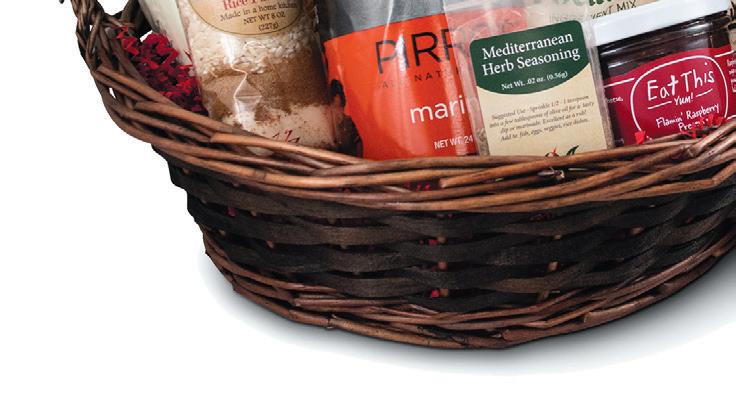



Epicurean Olive Oils

Epicurean has 60 of the highest-quality extra virgin olive oils, infused flavors and traditionally barrel-aged balsamic vinegars. They also carry a variety of local and specialty food products, making shopping for the foodie in your life effortless and fun. EpicureanOliveOils.com




Wildflower Winery
Small-batch low-intervention wines made in Ventura County from California Central Coast grapes. The low-intervention approach leaves the wine naturally vibrant, fruit-forward and wildly drinkable. Prices: $22–$32. WildflowerWineryVentura.com


28 WINTER 2022/23 Edible Ojai & Ventura County
GUIDE
GIFT






Fringe Shoppe

Carefully and lovingly curated home accessories, books, plants, fresh and dried flower bouquets, candles, tabletop, ceramics, special vintage jewelry and fine art. Many pieces handcrafted by established artists, locally and globally. Find on Instagram @fringeshoppe.
Sanctum




Handmade artisanal gifts to inspire peace, beauty and harmony. Sanctum honors and supports local and global artisans who respect the of ways of creating such as using organic materials and natural plant dyes. $45–$95. SanctumOjai.com







Mario’s Hard Espresso

Made from the 55-year-old Sicilian recipe of the owner’s father, Mario. Using 100% Arabica Dark Roast Espresso and Organic Madagascar Vanilla, each bottle is handcrafted in small batches with the same love and care he put into every one of his. Delicious over ice, as an Espresso Martini or as an addition to traditional cocktails and new creations. Naturally vegan and gluten free. $30–$38. To find a store, bar or restaurant close to you, or to purchase online and ship, go to DrinkMarios.com.



Edible Subscription

Edible Ojai & Ventura County produces four print issues per year, full of seasonal recipes, helpful how-to tips, inspiring local stories and useful farm, food and drink resources. Each subscription helps us to continue to support and celebrate the local chefs, artisans and growers who make Ventura County an extraordinary place to live and eat.


EdibleVenturaCounty.com/Subscribe-our-Magazine

sponsored content
WINTER 2022/23 29 EdibleVenturaCounty.com
Scan the code to reach this guide online
BUILDING A BETTER COVER CROP
Rodale Institute Supports Regenerative Agriculture in Ventura
 BY JENNIFER RICHARDSON
BY JENNIFER RICHARDSON
IN THE Field
30 WINTER 2022/23 Edible Ojai & Ventura County
California’s domestic leadership in organic farming.
When I arrive at the modest building housing the Rodale Institute California Organic Center at McGrath Family Farmers in Ven tura, local farming legend Phil McGrath and his wife, Joanne, are playing ping-pong. We have barely introduced ourselves before the Mc Graths pivot the conversation to the subject of pickleball, imploring me to give the wildly popular sport—of which they are enthusiasts—a try.
Between ping-pong and pickleball, it’s easy to assume I’m in the presence of happily retired people who have given themselves over entirely to a life of leisure. And McGrath did retire from farming his own land in 2017, turning that task wholly over to a handful of small certified-organic farmers, includ ing local CSA and farmers market staples like Baby Roots Farm. But it turns out Phil McGrath’s version of retirement is more active than many people’s version of full-time work, and, although he may enjoy a game of ping-pong while at the farm, he remains hard at work on his mission to promote regen erative agriculture.
One significant manifestation of this commitment to “a system of ag riculture that continuously improves environmentally, socially [and] eco nomically” was McGrath’s decision to partner with the Pennsylvania-based Rodale Institute in 2019 to establish its California outpost on McGrath Family Farmers’ land. In practice this means use of farm assets, including lots of old equipment; rental of office space and five acres for experimen tation and innovation; and, perhaps most critically, mentorship from Mc Grath for the small onsite Rodale team. Rodale brings the technology and knowledge from its 75-year history of organic, regenerative farming to help solve agricultural challenges that are more prevalent in California, including drought and wildfires, as well as pesticide use that remains at an all-time high despite California’s domestic leadership in organic farming.
While I would happily talk to McGrath all day, I’ve come to the farm
 Photos courtesy of Rodale Institute
Photos courtesy of Rodale Institute
Rodale brings the technology and knowledge from its 75-year history of organic, regenerative farming to help solve agricultural challenges that are more prevalent in California, including drought and wildfires, as well as pesticide use that remains at an all-time high despite
WINTER 2022/23 31 EdibleVenturaCounty.com
The pièce de résistance of Rodale machinery, the roller crimper is used to kill the organic cover crop.
to meet a key member of the local Rodale team, Research Director Arianna Bozzolo, who, with the help of Farm Manager Tony de Veyra, is responsible for much of the innovation work being done onsite. Bozzolo grew up in Bergamo near Milan, Italy, earning her bachelor’s, master’s and doctorate degrees in horticulture, entomology and viticulture respectively from the University of Padua, which she charmingly points out is “close to Venice, area of prosecco, sparkling wine.”
A requirement for her PhD program was to work abroad, which she satisfied by studying compost at the University of Arkansas. Af ter graduation, she returned there to work as a technician, moving through several more U.S.–based posts in both academia and private sector work related to viticulture before realizing that “making wine might not be the scope of my life.”
When Bozzolo saw the opening for the research director position at the Rodale Institute California Organic Center, she jumped at the chance. The pandemic dictated that her interview was done over Zoom, and upon being hired, she was told to “go to this address that day and do meaningful research.” Bozzolo was undaunted by the open-ended nature of what she had undertaken. Guided by Rodale’s mission of soil health, she got to work. “You want to do something good in your life, and Rodale gave me that chance.”
Under the auspices of two United States Department of Agricul ture (USDA) and California Department of Food and Agriculture (CDFA) specialty crop grants, a Healthy Soils Program CDFA grant and donations from organizations including Patagonia, Oxo and Patel Foundation, this currently looks like a series of experiments using cover crop instead of plastic mulch with the aim of creating a more sustainable way to grow. Rodale pioneered a system of no-till farming: growing cover crop, terminating it with a roller crimper—a piece of heavy equipment—and effectively growing your own mulch in the process.
NO TILL, NO HERBICIDES
“About 37% of U.S. farm acreage uses no-till farming, with strong adoption rates in the Northeast, the Mid-Atlantic states and the Mid west,” says Bozzolo. In the eastern United States, this is widely used for corn and soyabeans, but Bozzolo is trying this with crops that are more common in our region, starting with strawberries.

This is a challenge, both because strawberries are grown on raised beds, which makes using the roller crimper more difficult, and they’re delicate. But the theory is if it can work for strawberries, it can work for other crops.
For cover crop, Bozzolo is using sorghum. So far, an irrigation leak and the region’s marine layer have kept the sorghum from dying off completely as intended. And unlike in the eastern part of the U.S., she can’t rely on frost to do the job for her. Still, Bozzolo is undeterred, and is experimenting with alternatives like undercutting and roller crimping the sorghum twice. She knows the cover crop method is practiced successfully for non-organic farmers using
herbicide, and she’s resolved to find a way without it. “Cover crops plus herbicide [method] is more common in the eastern U.S. In our region (coastal), where we can produce cash crops all year long, the use of cover crops is not as common. However, with the megadrought we are experiencing, cover crops should be taken in consideration because [using them] can increase soil resilience.”
She’s also cheered by McGrath’s conviction, given his lifetime of experience in farming. “He was the first one who saw the roller crimper and said, ‘Yes, this can work,’” she says.
It’s time for a tour of Rodale’s five acres of experimentation, and we are reluctantly joined by Bozzolo’s fluffy gray dog, Papu, named for the Argentinian footballer Papu Gómez who once played for her hometown club. Bozzolo adopted him during the height of the pan demic, and McGrath agreed to let Papu accompany her to the farm with high hopes he would catch squirrels. His career as a field dog was less exalted than his namesake, scuppered by a squirrel that bit him in the tail in his first week on the farm.
With Papu finally coaxed into joining us on our walk, we start at a control patch of strawberries that are farmed with conventional plastic mulch, designed to keep the weeds down. Bozzolo points out there are still weeds. “What I want you to notice is it’s not a magic bullet. You need to weed anyway.”
Farther along we reach her current cover crop experiment with strawberries, where she points out the variable states of unplanned
32 WINTER 2022/23 Edible Ojai & Ventura County
survival of the sorghum. She’s interested in experimenting more with how the strawberries were transplanted, working the soil more or changing the amount of water. Another system she’s trying is inter cropping with clover, which is a legume so it can “fix” nitrogen from the air to provide nutrients to the strawberries—something plastic decidedly cannot do.
Her job, she tells me, is “to try something that the growers cannot afford or don’t have the time or the money or don’t want to. I can do all the mistakes they cannot do until I’ve found the system.”
Next, she points out a spot where she will soon start a pumpkin project with oats and peas as cover crop. Pumpkins are a strong plant with big seeds and big fruit, and she’s confident she’ll see better re sults than with more delicate strawberries. She’s also excited about trying peas as a cover crop because they’re edible.
MONITIZING COVER CROPS
“The growers don’t want to grow cover crop because it’s a waste of time and land. But I noticed here growers grow peas and sell tendrils at the farmers’ market. At least it’s an income the growers can have while they’re growing cover crop.”

Bozzolo is keenly aware that adoption of the techniques she’s pi loting depends on their financial viability, and each of her projects includes an economic analysis at the end.
Another experiment had economics front and center, aiming to help an Italian textile company create a closed-loop economy for its denim production. The trial is using the fluffy cotton byproduct of that production in soil growing cotton—which in its untopped state looks like hibiscus to my untrained eye—to determine if it helps the cotton plant retain moisture.
Findings so far indicate the byproduct material degrades in 12 weeks, so Bozzolo does not expect to see any impact since cotton has a longer growing cycle. However, she speculates that with tomatoes or peppers, which have a shorter growing cycle, she may be able to demonstrate a difference in growth or amount of fruit. It’s not the closed-loop economy the textile company was hoping for, but such is the path of much innovation: Benefits often accrue outside the originally intended use.
Speaking of peppers, Bozzolo points out the spot where she is planning an experiment with them alongside zucchini and eggplant. The three crops have been selected because they have different grow ing cycles: short, medium and long. This will allow her to measure how long she can make the cover crop mulch last across the different growing cycles.
Intercropping, the practice of cultivating two or more crops in a field simultaneously, has advantages, including water use efficien cy and the potential for the benefits of companion planting, such as when two vegetables grown in proximity can help repel pests. However, Bozzolo also explains that mechanical harvesting presents a challenge to operationalizing intercropping with crops that have growing cycles of different length. It’s hard for a machine to harvest well at the level of detail needed for the varied plant growth.
And machinery is an important part of the overall equation in all Bozzolo’s experiments. If, for example, a farmer can no longer use their expensive piece of machinery that has historically been used for putting down plastic mulch, can they use it for something else? These are all questions Bozzolo knows she needs to answer. She realizes she’s dealing with the challenge of how to drive behavioral change, not just scientific experiments.
Back on our tour, we come to the pièce de résistance of Rodale machinery: the roller crimper used to kill the organic cover crop. It’s made of dusty red metal with a signature chevron design to the roller, and it was the first piece of equipment Rodale sent Bozzolo, even before she had a tractor to pull it. (McGrath has since provided a 1980s model tractor, and they have applied for a grant that will help them buy an electric tractor, which McGrath believes will be the first in use in Ventura County.) Bozzolo got the message inherent in the roller crimper’s arrival. She recounts with a laugh her realization at the time: “I guess this is my research.”
And it did take some research to figure out how to best put the roller crimper into service. They worked out some details by trial and error, learning about parameters like wind direction and whether you always need to crimp on the same side (you do). Despite the diffi culties, throughout our conversation Bozzolo remains resolute, not
WINTER 2022/23 33 EdibleVenturaCounty.com
just about the roller crimper, but about all her experiments with regenerative agriculture.

“I believe it can work. We just need to nail down the details. And to do that, we need just to try.”
So far Bozzolo has focused on the innovation work she is doing with Rodale and Mc Grath, paying close attention to how this can be operationalized at scale by farmers. But before I go, I ask for her thoughts on the role of consumers in this ecosystem.
Bozzolo tells me about Regenerative Organic Certified (ROC), a certification pro gram that builds on the USDA Organic certification and existing animal welfare and social fairness standards bodies. First piloted in 2017 with participation from the Rodale Institute on the Soil Health Advisory Committee, a handful of early adopters have since earned the ROC designation. These include Ventura County companies like Patagonia, for its Regenerative Organic Chile Mango from its Patagonia Provisions line (made in Sol Simple, Masaya, Nicaragua), as well as Moorpark’s Apricot Lane Farms’ avocado oil.
Bozzolo is hopeful that in the future this certification will help consumers more easily identify and purchase organic, regeneratively farmed goods. However, she acknowledges the reality that there is not yet a critical mass of ROC products available in supermarkets. In its absence, Bozzolo urges people to eat certified organic.
“It’s good for us to eat organic for the environment, but sometimes you don’t have to do things for the environment. Just do it for yourself or for people who you love.” For more about Rodale Institute and how you can support the mission visit RodaleInstitute.org.
Jennifer Richardson is the author of Americashire: A Field Guide to a Marriage, an Indie Reader Discovery Award winner for travel writing. She and her British husband consider themselves lucky to call both Ventura and a village in the English Cotswolds home. To learn more, visit JenniferRichardson.net.
34 WINTER 2022/23 Edible Ojai & Ventura County
A handful of early adopters have earned the ROC designation. These include Ventura County companies like Patagonia, for its Regenerative Organic Chile Mango from its Patagonia Provisions line (made in Sol Simple, Masaya, Nicaragua), as well as Moorpark’s Apricot Lane Farms’ avocado oil.
A cotton blossom




WINTER 2022/23 35 EdibleVenturaCounty.com
SHEPHERD’S PIE


with Sweet Potato and Chimichurri Sauce

This recipe, adapted from The Apricot Lane Farms Cookbook, is by Molly Chester, a co-founder and farmer of Apricot Lane Farms, a 234-acre biodynamic farming project in Moorpark, California. Prior to farming, Molly was a private chef in Los Angeles, who specialized in healing the gut through nutrient-dense culinary techniques such as soaking, sprouting and fermenting. She lives on the farm with her husband, John, son, Beaudie, dog, Blue, and a menagerie of farm animals and wildlife. Molly and John’s gentle, slow and unconventional approach has inspired other farmers, and was the subject of the 2019 award-winning documentary The Biggest Little Farm

This debut cookbook brings the bounty of the farm to readers’ kitchens. As a chef who has long understood that flavor and healthy food go hand in hand, Chester is passionate about farm-fresh ingredients, and her cooking celebrates the tree-ripened fruits, seasonal vegetables, pastured eggs and grass-fed meats for which the farm is known.
This savory pie is a comforting and flexible favorite that, when made in advance and frozen, allows us to feed a group in a pinch. The pie and chimichurri sauce can be made separately up to 6 months in advance and thawed in the refrigerator the night before it is baked. Mutton is excellent in this dish, and the chimichurri sauce both brightens and complements the strong flavor of mature meat. If you cannot source it, substitute grass-fed ground lamb or ground beef instead. Orange sweet potatoes provide a gorgeous presentation, but slightly drier white sweet potatoes work as well.
EDIBLE Excerpt
Photos Courtesy of Molly Chester
36 WINTER 2022/23
Edible Ojai & Ventura County
Serves 8 to 10
For the chimichurri sauce
1 cup loosely packed finely minced fresh parsley leaves (1 bunch)
1 tablespoon minced jalapeño pepper (about 1 medium pepper)
1 tablespoon minced garlic (3 cloves)
¼ cup minced red onion (about ¼ large onion)
1 teaspoon fine sea salt
½ teaspoon crushed red chile flakes
¼ teaspoon freshly ground black peppercorns
2 tablespoons plus 2 teaspoons red wine vinegar
¾ cup cold-pressed extra virgin olive oil
For the pie
7 small orange sweet potatoes (about 4 pounds)
4 teaspoons unsalted butter
3½ teaspoons fine sea salt
2 teaspoons freshly ground black peppercorns
2 tablespoons lard
2 pounds ground mutton
1 cup minced carrot (about 3 medium carrots)
1 cup minced yellow onion (1 large onion)
1 cup minced celery (about 3 stalks)
2 tablespoons minced garlic (6 cloves)
1 tablespoon fresh thyme leaves or 1½ teaspoons dried
1 (18.3-ounce) jar crushed tomatoes
1 tablespoon raw apple cider vinegar
1 cup fresh or frozen shelled peas
Make the chimichurri sauce: In a small food processor, place the parsley, jalapeño, garlic, onion, salt, chile flakes, pepper, vinegar and oil. Pulse to combine, transfer to a serving dish and set aside.
Preheat oven to 350°F and position a rack in the middle.
Make the pie: Line a large baking sheet with parchment paper and place sweet potatoes on top. Transfer to oven and bake for about 45 minutes, or until fork tender. Remove from oven and set aside until cool enough to handle, 10 to 15 minutes. Remove and discard skin and place flesh in the bowl of a food processor. Add butter, 1½ teaspoons salt and 1 teaspoon pepper, and purée until smooth and creamy, scraping down the sides as needed. Increase oven temperature to 375°F.
In a 10-inch cast-iron skillet, heat 1 tablespoon lard over medium-high heat. Add half the ground mutton, 1 teaspoon salt and ½ teaspoon pepper. Cook, stirring with a spoon, until meat is dark brown and crumbled, 7 to 10 minutes. Transfer to a large baking sheet and repeat with the remaining mutton.
Reduce heat to medium and add carrots, onion, celery, garlic and thyme to the skillet with the residual mutton fat. Sweat the vegetables until the onion becomes translucent, 4 to 5 minutes. Transfer mutton back to the skillet and add the crushed tomatoes and vinegar.
Increase heat to medium-high, stir well and cook for 10 minutes. Stir in peas and cook for an additional 5 minutes. Transfer mixture to a 9- × 11-inch casserole dish and spread evenly.
Scoop puréed sweet potato over top of tfilling. Using a spatula, smooth out the top to create an even, attractive layer. Place casserole in the oven and bake for 30 minutes, or until filling begins to bubble.
Turn the broiler on medium and broil the pie for an additional 4 to 6 minutes on the middle rack to brown the top, keeping in mind that broiling intensity will vary by oven.
Remove pie from oven and let it cool for 15 minutes to set. Serve warm with the chimichurri sauce on the side. Let cool completely and store, covered, in the refrigerator for up to 5 days or in the freezer for up to 6 months.
Cooking Tip: Browning Meat
Taking the time to brown pastured meat only enhances its flavor! Cook in small batches to crispy perfection on the stovetop whenever possible. During cooking, meat undergoes many chemical changes affecting its appearance, taste and texture. Browning or searing leaner pastured meat produces the rich, deep colors, flavors and aromas that we love. This browning process is known as the Maillard reaction.

WINTER 2022/23 37 EdibleVenturaCounty.com
Apricot Lane Farms co-founder and farmer Molly Chester’s second cookbook was released this fall and is available for order at ApricotLaneFarms.com/cookbook.
LOCAL LOVE PROJECT
Local Love Project, a Ventura County–based disaster relief 501(c) (3) non-profit organization helping those in Ventura County affected by the Coronavirus and Thomas Fire. The primary goal of Totally Local VC’s Local Love Project is to activate and organize members of our community in the aftermath of a disaster within our 805 communities and to provide relief and support to those affected by disaster. “This is Local helping Local.”

totallylocalvc.com/local-love-project #LocalLoveProject #805Strong #TotallyLocalVC
Ways the organization offers support:

• One on one help.
• Collection of needed items.
• Distribution to those in need in the 805.
• Working in Partnership.
© 2022 LIV Sotheby’s International Realty. All rights reserved. Each Office is Independently Owned and Operated.
LIV Sotheby’s International Realty is honored to sponsor Totally Local and the Local Love Project whichwork to solve the immediate needs of those impacted by California disasters by providing items necessary to help our neighbors as they work to restore their lives.

livsothebysrealtyca.com
727 West Ojai Avenue, Ojai, California 93023 554 East Main Street, Ventura, California 93001
38 WINTER 2022/23
&
County
Edible Ojai
Ventura
FROM ITALY TO VENTURA COUNTY
Global lessons learned from cooking school in Italy
 WORDS AND PHOTOS BY AVERY LIEB
WORDS AND PHOTOS BY AVERY LIEB
When you think of Italian food, you might just conjure up images of fresh homemade bread and pasta, alongside sumptuous salami, basil, tomato, mozzarella and perhaps multiple bottles of local wine (or in my case, since I’m 15, olive oil!) But there’s so much more to this magnificent food than Instagram-ready images.
This past summer I traveled to an organic farm on the provincial border of Umbria and Lazio to fulfill my dream of experiencing this Tuscan food utopia, and to better understand the farming methods behind it, firsthand. Yes, the food is INSANELY superb, just as it is in Ventura County, but I also learned that behind the scenes (aka, on the farm) there are concerning environmental issues similar to problems found in Southern California. Namely, Tuscan farmers grapple with a crippling drought, rising energy costs, depleted soils and exorbitant waste.
It’s not all doom and gloom, however. My goal is to share their clever long-tested methods for dealing with these big problems to lend insight as we confront those same issues here. I am also including a couple heavenly recipes I picked up along the way, because there’s no better way to have life-changing conversations than while enjoying a homemade, delectable, Tuscan-inspired dish.

YOUNG Voices
WINTER 2022/23 39 EdibleVenturaCounty.com WINTER 2022/23 39 EdibleVenturaCounty.com
COPING WITH CRIPPLING DROUGHT
Tuscan farmers are seeking innovative methods of farming to cope with climatic changes like extreme drought. The summer of 2022 was the hottest in Europe’s recorded history, with the worst drought in centuries. According to Stefano Patuanelli, Italy’s agriculture minister, this could endanger 30% of Italy’s agricultural production, threatening the output of staples like tomatoes.


In drought conditions, tomato plants exhibit myriad signs of stress that are often fatal to the plants: reduced growth, flower drop, mineral de ficiency, fruit breakage, flower rot and poor seed viability. This summer, I learned of a traditional farming method used in modern ways to con serve water called “dry farming.” On the farm where I worked, dry farming tomatoes meant the fruit was grown with a rich, robust and pro ductive soil, built up with compost and mulch. Once the plants are established, typically in the dry season, the farmers stop watering the plants, at which point the roots dig deep for water and the plants’ energy is spent on growing their fruit. The result: a smaller, denser, more flavorful to mato grown thoughtfully during a drought with no water. This practice has deep historical roots and has been used around the world by various people, and it’s exciting to see it used in new ways as we face a worldwide farming crisis.
AVOIDING TROUBLING TRANSPORTATION
Another major issue that affects both Italy and Ventura County is the energy-intensive and cost ly transportation of produce. To conserve energy and resources, Italians are encouraging farmers and consumers to sell and buy locally and in season. We are likewise lucky in Ventura Coun try to host robust and frequent farmers’ markets that provide us ample opportunity to save energy and money while supporting local farmers—and nothing beats food fresh off the farm!
Local Tip: This winter, let’s buy local citrus in season and locally grown papayas instead of those grown elsewhere. Tuscany and Ventura County are fortunate to have this fruitful option!
40 WINTER 2022/23 Edible Ojai & Ventura County
MOVING AWAY FROM MONOCULTURES
Globally, monoculture crops deplete the soil and waste resources, especially water. When many acres are devoted to one single type of plant, monoculture crops lack the natural forms of pest control found in diverse environments and therefore require more harmful pesticides. I wit nessed Italians implementing crop rotation and plant diversity to improve the soil quality and its ability to retain moisture, minimize pesticides and, importantly, improve the quality of the food.
I loved watching chickens forage in the Tuscan olive tree orchards while naturally providing fertilizer and pest control for the olive trees. Symbiotically, the trees provide shade and food for the chickens, thereby improving egg quality.
Local Tip: As consumers we can encourage and support the Ventura County farmers who em brace this diverse, symbiotic system approach.
MAKING A WASTE - LESS WORLD
I was truly dumbfounded by how little Italians waste in all areas of life. The people relax in the shade during the hottest hours of the day rather than work in air-conditioned spaces. Glass jars are reused. I never used or even saw plastic. Very little excess food was cooked at all beyond what we ate, and anything not eaten was given to the animals on the farm (minimizing the need for corn feed).
According to USDA data, it is estimated that 30–40% of food production in the United States goes to waste. Over the past decade, research on food waste in Italy has limited data, but current estimations run 4–17% of food produced.
Research on Italian culture and food waste reported in 2021 by Maria Luisa Scalvedi and Lau ra Rossi of the Research Center for Food and Nutrition in Rome confirms what I witnessed: In Italy, throwing away food is associated with a negative emotional experience; and Italians report that reducing food waste would contribute to a better world. Meanwhile, according to a survey published in the journal PLOS One by Johns Hopkins Center for a Livable Future, about three quarters of surveyed U.S. Americans perceive themselves as wasting very little food, and certainly less than the national average.
Italians are working to promote the value of food and to shift social norms so that wasting food is no longer socially acceptable, especially targeting younger and larger households. After my experience living less wastefully, I hope to promote this ethic here at home, using as little as possible and reusing as much as possible, like my Italian friends.
BRINGING IT HOME
While many Ventura County farmers are working hard to reduce their environmental impact and transition to more sustainable farming practices, my Italian experience—and the scale of our current environmental problems—have shown me the need for global effort and communi cation. From dry farming and buying locally and in-season to implementing diverse agricultural systems and waste-free production, I’ve learned uplifting ways to tackle issues ranging from drought and transportation to monocultures and waste. Imagine if every farm in the world tried to approach the current climate crisis with such open-minded innovation! Let’s learn from this farm, and from each other, because this worldwide crisis demands a concerted global response that starts, connects and grows at the roots we all share.
Avery Lieb, a 10th grader at The Thacher School in Ojai, enjoys friends, family, good food and writing about good food. She feels strongly that affordable, sustainable, healthful food will dramatically improve local communities and our connected broader world.
WINTER 2022/23 41 EdibleVenturaCounty.com
I was truly dumbfounded by how little Italians waste in all areas of life. The people relax in the shade during the hottest hours of the day rather than work in air-conditioned spaces. Glass jars are reused. I never used or even saw plastic. Very little excess food was cooked at all beyond what we ate, and anything not eaten was given to the animals on the farm (minimizing the need for corn feed).
PIZZA WITH DRY - FARMED TOMATOES
 By Avery Lieb
By Avery Lieb
It’s common in Italy to use weight measurements, but they can be replicated easily with a simple kitchen scale. Estimates for volume conversions are in parenthesis but are rough and can vary depending on the freshness of your ingredients.
IMPORTANT NOTES: Make the dough one day before you plan to serve the pizza. Also, for the best flavor, use ONLY the best quality, locally sourced ingredients.
Makes 4 (12-inch) pizzas
For the dough:
600 grams bread flour (about 4⅔ cups)
360 grams water (about 1½ cups), at room temperature
10 grams olive oil (1½ tablespoons)
10 grams salt (2–3 teaspoons)
Either ¼ teaspoon active dry yeast or 30 grams sourdough starter (about 2 tablespoons)
Add all ingredients to a bowl and mix together by hand or with a mixer until a dough forms and all ingredients are incorporated with no flour left sticking to the sides of the bowl.
Dough will be slightly stiff and won’t quite stick to your hands. Cover bowl with a towel.
Let rest for 30 minutes.
On a lightly floured surface, knead dough 5–6 times, return to bowl, cover and let dough rise in a warm location for 4 hours. The dough will look slightly larger but not doubled in size.
Shape the dough into 4 dough balls, about 250 grams each. Place in a covered dough tray or sheet pan covered with a towel and refrigerate 24 hours.
Take dough out of refrigerator 2 hours before you plan to make the pizzas, to bring to room temperature. Leave covered until ready to shape.
With your hands or a rolling pin on lightly floured surface, shape dough into 12inch round or rectangular pizza pies. For thinner pie, stretch to 14 inches; for thicker pie, 10 inches.
When placing ingredients on shaped pies, leave dough on floured cutting board for easy transfer to pizza stone. If you have a pizza paddle, all the better!
For the topping:
2 cups puréed whole, organic, peeled tomatoes, dry-farmed if possible (seeds optional)
10–12 ounces whole-milk mozzarella cheese, diced into small chunks
1 cup grated Parmesan or pecorino Romano
1 bunch basil, torn or sliced just before applying to pizzas
Several sprigs oregano
Set the oven to the hottest possible temperature, 525–550°F; if your oven doesn’t go that high, use high broil. Put baking stone in oven to preheat for 30 minutes to an hour.
Layer ingredients as desired onto the pizza dough (see Chef’s Note for basil). Carefully transfer loaded pies to baking stone or alternative heating surface.
Bake each pizza on baking stone for 5–7 minutes, or until cheese is melted and crust is golden.
Chef’s Notes:
1. If you don’t have a pizza stone, an inverted baking sheet or a large cast-iron pan can be used instead.
2. To prevent the basil from burning, either add it before adding the cheese or after the pizza is baked.
3. Feel free to add additional fresh seasonal ingredients after cooking, as desired: arugula, fresh sliced tomatoes, red onions, etc.
42 WINTER 2022/23 Edible Ojai & Ventura County




WINTER 2022/23 43 EdibleVenturaCounty.com
SEASONAL WINTER SALAD
By Avery Lieb
For this salad, adjust amounts based on your personal preferences. There is no wrong way to go. Experiment to see what you like the best! Serve as a main dish or alongside the Tuscan-inspired pizza.
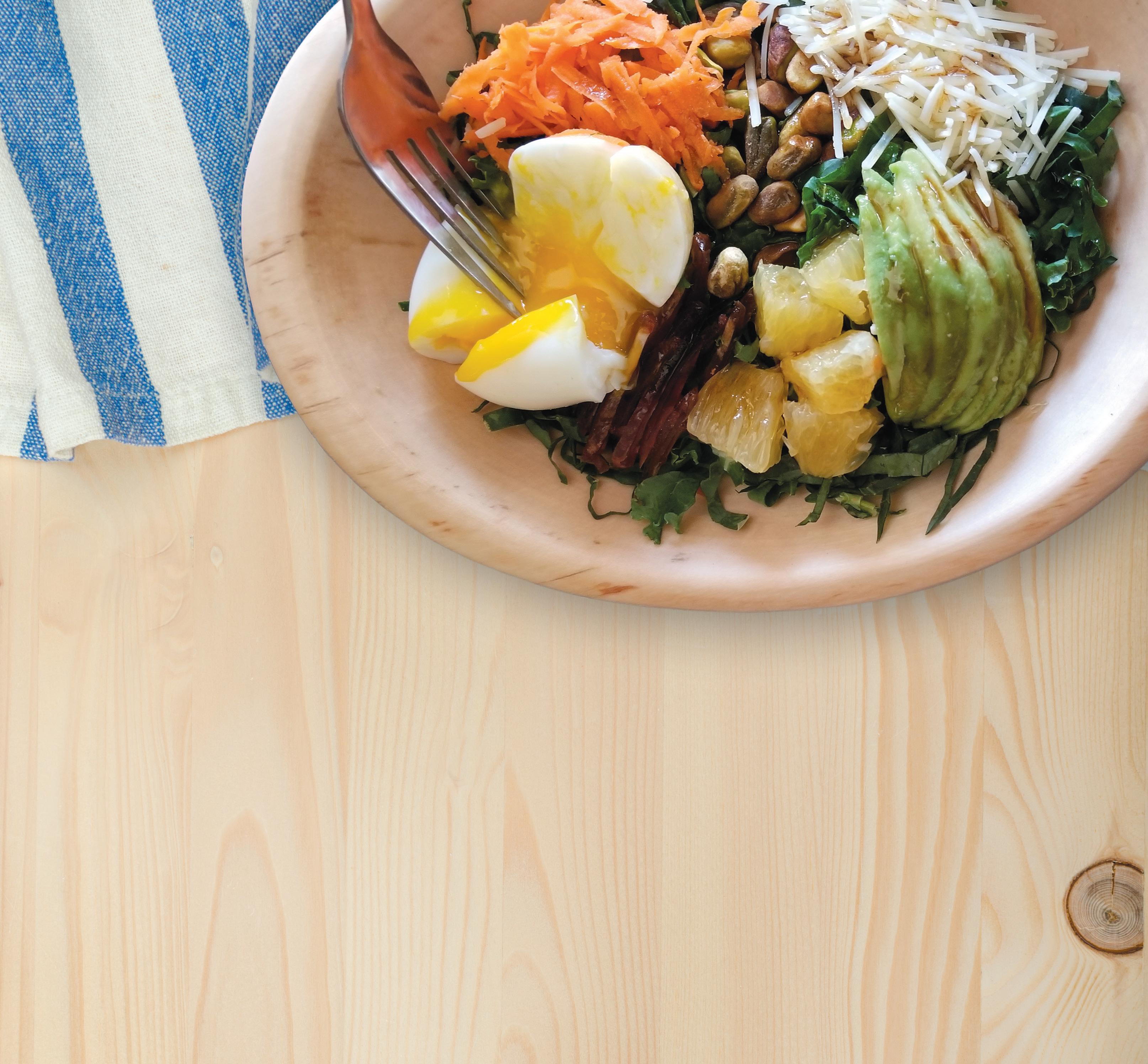
Serves 1–6
1 bunch kale
Oranges, peeled and sliced Avocados, sliced Carrots, shredded Pistachios, shelled Dates, chopped
Soft boiled eggs, sliced Grated Parmesan Balsamic vinegar* Extra virgin olive oil*

Strip stems from the kale leaves and compost. Chop leaves finely and massage by hand for at least a minute.
For the dressing: Mix 1 part balsamic vinegar to 3 parts olive oil and shake or whisk vigorously just before serving.
Add all salad ingredients to a large bowl or individual plates. Drizzle with dressing and toss, or serve with just the drizzle over the top.

*Chef’s Note: I’m partial to Ojai Olive Oil’s Pomegranate Balsamic and Pixie Olive Oil combination!
For more recipes inspired by Avery’s Tuscan travels, visit EdibleVenturaCounty.com.
44 WINTER 2022/23 Edible Ojai & Ventura County
BowlbyWoodBowl.com
Offering a large selection of books on food and cooking, as well as all other subjects.





WINTER 2022/23 45 EdibleVenturaCounty.com








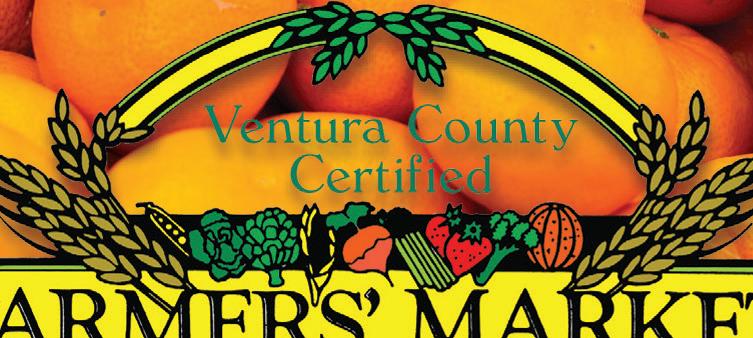



























































































46 WINTER 2022/23 Edible Ojai & Ventura County Get Your Vitamin “C” Here! Vitamin “C” Here! WEDNESDAYS MIDTOWN VENTURA Pacific View Mall 9:00 am - 1:00 pm Front West Parking Lot on Main Street THURSDAYS THOUSAND OAKS The Oaks Mall 12 noon - 5:00 pm East End Parking Lot on Wilbur Road SATURDAYS DOWNTOWN VENTURA NEW LOCATION!!! 8:30 am - 12 noon 200 Block of Main Street “On the Street” SUNDAYS SANTA CLARITA College of the Canyons 8:30 am - 12 noon Parking Lot 5 Rockwell Canyon Road Follow our markets on Social Media by visiting our website at www.vccfm.org www.vccfm.org CONNECT WITH US : 805.529.6266 WIC, CAL-FRESH/EBT & MARKET MATCH ACCEPTED HERE @vccfm @vccfm Fresh Nuts, Dried Fruits & Candies Huge Selection of Gift Packs 4475 E. Los Angeles Ave., Somis 805-386-1211 • 800-266-NUTS Open 7 Days Tue–Sat, 10am–5pm 300 N. Lantana St. #37, Camarillo Tea-Liteful.com 805-445-8327 Call for reservations • European Tea Room • Over 130 Specialty Teas • Cream Tea, Afternoon Tea, High Tea • Bridal Showers, Baby Showers, Catering BellaCopper The Original Solid Copper Heat Diffuser, Defroster Plate & Oven Plate Copper conducts heat better! Made in Ventura, CA since 2002 www.BellaCopper.com edible Ojai & Ventura County Marketplace To join, contact us at info@edibleventuracounty.com
To Forage or Not to Forage







Can we do it sustainably and ethically?

Drive or hike by any open space in Ventura County in the springtime and you’ll no doubt notice rolling hills of bright yellow flowers—wild mustard, one of California’s invasive plants. As human populations have moved across the world, plants and animals have followed, sometimes intentionally but often unintentionally. These nonnative organisms can cause serious problems as they outcompete native plants for their resources, leading to biodiversity loss and creating monocultures.


This displacement alters the delicate balance of the ecosystem, affecting every level of the food chain. Over $26 billion per year since 2010 has been spent in North America in the fight against invasive species to protect property values, agricultural returns and conservation of native landscapes. The conventional and cost-efficient way to deal with these plants has been to use controversial herbicides such as glyphosate and triclopyr—chemicals that ultimately end up in our soil and waterways, affecting native species and the whole ecosystem. Not to mention, these efforts have done little to make lasting change in restoration of natural habitats and often have to be retreated year after year.
But what if we EAT these invasive species instead?
Many of the problem-causing invasive species are actually edible and even medicinal. (Though some are very poisonous and even deadly, such as poison hemlock—please do you your research and consult a guide before eating any wild plant.) Some tasty edible invasive plants to look for are dwarf nettle (Urtica urens), purslane (Portulaca oleracea), the multitude of mustard species (Brassica sp.), chickweed (Stellaria media), common mallow (Malva neglecta), wild radish (Raphanus raphanistrum) and, of course, dandelion (Taraxacum officinale), among countless others. These plants are common in urban areas, gardens and lawns, parks, empty lots and open spaces. When foraging, be mindful of possible contaminants in high-traffic areas—you’ll be eating what the plant has absorbed throughout its life cycle.

Managing invasives isn’t just a springtime garden chore. Even in the fall and winter, once these plants have gone to seed many have edible seeds that can be collected and eaten. This prevents them from reseeding and expanding their population once spring comes around again. For example, wild mustard


022/23 47 EdibleVenturaCounty.com WINTER 2022/23
FORAGING Finds
PHOTOS AND WORDS BY JESS STARWOOD
WINTER 2022/23 47 EdibleVenturaCounty.com
seeds (from species such as Brassica nigra or Hirschfeldia incana) can be collected to make the popular condiment of the same name. Plan tain seeds can be used for their water-absorbing characteristic that is similar to chia. Others like cheatgrass and wild oats are grains that can be collected and used in place of commercial grains.
What Is The Cost?
Naturally, conservationists oppose foraging of any kind. What if ev eryone did it? What if foragers took everything in their path? Won’t it disrupt an already fragile ecosystem?
The conservationists’ argument is valid in that undereducated foraging may cause damage to the environment with unethical har vesting practices and quantities. While their argument has merit— we don’t get foraging lessons in school and often lack any sort of immersive nature education—foraging wild food is much different than shopping at the local market and hardly likely to be as popular.
But on that topic, do we really know where our commercial food comes from? Even though we only see the neat little package from the supermarket, it originally came from a large swath of raw earth that was scraped clean of a diverse natural habitat (the same kind that conservationists are trying so desperately to protect) and replaced with a monoculture crop that displaces native inhabitants and de pletes the soil of important nutrients within years.
How Can We Find a Balance?
Psychology research indicates that the closer we are to nature, the more we interact with it on a daily basis and the more educated we
are about the land around us, the more likely we are to respect and protect it. As the fight against invasive species continues, we can choose less harmful methods to seek balance in nature.
A specific example of working with imbalances in nature is the population of the purple sea urchin (despite being a native species), which in recent years has grown exponentially due to climate change. This population increase is destroying the kelp forests off the Califor nia coast. One effective way to control the purple urchin has been to encourage chefs to put them on the menu in hopes to reduce their numbers and regain balance in the kelp forests. This is an excellent example of managing the environment in a positive way by harvest ing the excess.
At Home
Managing invasive species starts in your backyard by choosing native species when adding plants to your property and by harvesting those plants before they go to seed. This is also a great way to use native plants that would otherwise be illegal and/or unethical to collect in the wild.
Educating oneself on accurate species identification plus ethical and sustainable harvesting practices is crucial to introducing foraging as a positive method to managing the landscape.
Jess Starwood, an herbalist, forager and chef based in Thousand Oaks, educates about wild food, herbal medicine and our natural connection to the land through what we eat. She has a master’s of science degree in herbal medicine and is the author of Mushroom Wanderland: A Forager’s Guide to Finding, Identifying and Using 25 Wild Fungi, available from JStarwood.com.

48 WINTER 2022/23 Edible Ojai & Ventura County
Beatrice Wood, known as the “Mama of Dada”, lived until 105 and created art every day. One of the few women to pioneer an avant-garde movement, Wood made her mark in the art world with gravitas and whimsy. Beato Chocolates was anti-established in Ojai to honor this trailblazing woman. Woman-owned and artist focused, our handcrafted, Fair Trade Certified bars, use the finest, locally sourced ingredients. Ojai, Wood said, was like finding “the gold at the end of a long obstacle-strewn rainbow.” Beato Chocolates offers a sweet taste of her special valley.



















WINTER 2022/23 49 EdibleVenturaCounty.com
“I owe it all to chocolate, art books and young men.”
ANTI-ESTABLISHED
-Beatrice “Beato” Wood
IN OJAI, CA
Beato Chocolates | 310 E. Matilija Ave., Ojai, CA 93023
| www.beatochocolates.com
Located inside the Porch Gallery Ojai
El Jardin Courtyard 451 E. Main St. Ventura, CA. 93001 hello@fringeshoppe.com WINE • BEER • FOOD WINE • BEER • FOOD 2423 Ventura Blvd., Camarillo, CA 93010 (805) 383-9812 | wineclosetinc.com Featuring artisan wine and craft beer by-the-glass or bottle. Creative food menu and gourmet Panini. Serving lunch and dinner. HOURS Monday Closed | Tue/Wed 12–7PM Thur/Fri/Sat 12–9PM | Sunday 12–5PM WINE CLUB DISCOUNTS WINE TASTING THUR-SUN BOTTLE SHOP, WINE BAR & CHEESE MARKET This Spot’s for You!
WEDNESDAYS
1 Midtown Ventura
Certi ed Farmers’ Market
Paci c View Mall (West End Parking Lot) 3301 N. Main St. Wednesdays, 9am–1pm (rain or shine)








VCCFM.org 805-529-6266
THURSDAYS
2 Downtown Oxnard
Certi ed Farmers’ Market
Plaza Park, 5th St. & B St. Thursdays, 9am–1:30pm (rain or shine)
OxnardFarmersMarket.com 805-247-0197
3 Ojai Community Farmers’ Market

Chaparral Courtyard, 414 E. Ojai Ave. Thursdays, 3–7pm OjaiCommunityFarmersMarket.com 661-491-0257
4 Thousand Oaks
Certi ed Farmers’ Market
The Oaks Shopping Center (East End Parking Lot)






Wilbur Rd. & Oaks Mall Dr. Thursdays, noon–5pm (rain or shine)







VCCFM.org 805-529-6266





FRIDAYS
5 Santa Paula
Certi ed Farmers’ Market
Santa Paula Train Depot, 200 N. 10th St. Fridays 3–7pm EnrichedFarms.com



6 Simi Valley



Certi ed Farmers’ Market

Civic Center Plaza, 2757 Tapo Canyon Rd. Fridays, 11am–3:30pm (rain or shine)
Facebook.com/SimiValleyMarket 805-643-6458
SATURDAYS
7 Agoura Hills
At Whizin Market Square
28914 Roadside Dr. Saturdays, 9am–2pm @ccfminc
8 Camarillo Hospice

Certi ed Farmers’ Market 2220 Ventura Blvd., Old Town Saturdays, 8am–noon (rain or shine) CamarilloFarmersMarket.com 805-987-3347
9 Downtown Ventura Certi ed Farmers’ Market «NEW LOCATION! « 200 Block of Main Street
From Palm to Mission Park Saturdays, 8:30am–noon (rain or shine) VCCFM.org | 805-529-6266
SUNDAYS
10 Ojai Certi ed
Farmers’ Market Behind the Arcade at 300 E. Matilija St. Sundays, 9am–1pm (rain or shine) OjaiCerti edFarmersMarket.com 805-698-5555 11 Moorpark Certi ed Farmers’ Market 450 E. High St. Sundays, 9am–2pm EnrichedFarms.com | 818-699-6204 12 Community Market At Oxnard College Campus Parking Lot Sundays 8am–3pm Maria_olivares2@my.vcccd.edu 13 Channel Islands Harbor Farmers’ Market Marine Emporium Landing 3350 S. Harbor Blvd., Oxnard Sundays, 10am–2pm (rain or shine) RawInspiration.org | 818-591-8161 14 Saticoy Certi ed Farmers’ Market Saticoy Park 11321 Violeta St. First Sundays only, 10am–2pm saticoyfarmersmarket.org 15 Westlake Village Farmers’ Market 2797 Agoura Rd. Sundays, 10am–2pm (rain or shine) RawInspiration.org 818-591-8161 WEEKENDS 16 Ventura College Foundation Weekend Marketplace Ventura College East Parking Lot Corner of Telegraph Rd. & Day Rd. Saturdays & Sundays, 8am–2pm VenturaCollegeFoundation.org 16 1 Ventura Oxnard Ojai Saticoy 2 3 edible® Ojai & Ventura County Ventura County Farmers’ Markets 9 10 12 13 14 50 WINTER 2022/23 Edible Ojai & Ventura County
This list was updated August 2022, but as details do change please contact the markets for the latest info. If you know of another farmers’ market that is not listed, please let us know at info@edibleventuracounty.com. See EdibleVenturaCounty.com for CSA information.





























Camarillo Newbury Park Thousand Oaks Westlake Village Simi Valley Moorpark Santa Paula Agoura Hills 4 5 6 7 8 11 15
WINTER 2022/23 51 EdibleVenturaCounty.com
Illustrations by Claudia Pardo
WHAT IS SUSTAINABILITY ?

 PHOTOS STYLED AND RECIPES BY ROBIN GOLDSTEIN
PHOTOS STYLED AND RECIPES BY ROBIN GOLDSTEIN

It feels as if we all are caught up in a wave of never-ending work. On one hand, I personally thrive on that. On the other, it is sometimes overwhelming and makes me think, “What I am doing with my moments of free time when I’ve got meals to prep, articles to finish, recipes to test, a mound of dishes to clean, social media to post, errands to run and this feature that needs attention?”
I have no choice but to re-evaluate. And then I say to myself, “How much goes into all I do every day? Is this the nature of sustainability?”
When your job and entire life are focused on working in the kitchen, as mine are, it’s a great place to stop and focus on making small realistic changes to my lifestyle, from the food I buy to the way I cook my meals.
We can save energy and reduce our carbon footprint in many different ways, mainly by buying local and supporting our surrounding
community. How do you remain sustainable and support your local community?
Working on this season’s issue of Edible, I thought I’d leave you with a little recipe that only takes 30 minutes to prepare if you have an Instant Pot or pressure cooker; or you could take a leisurely afternoon and prepare this in a slow cooker or stove top method. And I ask you to ponder: Is sustainability about balanced intentional living or instant gratification?
Chef Robin Goldstein’s cooking career has been centered in California, where she has been preparing foods for 30+ years. She brings to the table a deep-felt art of balancing flavors while interacting with her private clients in their homes. She shares her delicious recipes through her popular cookbooks, perfectly paired for those who seek savory Mediterranean-inspired flavors. PrivateChefRobin.com
ROBIN’S Recipes
& Ventura County
Edible Ojai
TUSCAN WHITE BEANS
Serves 4
½ cup good-quality olive oil, divided 4 cloves garlic, sliced ½ teaspoon red chile flakes
½ teaspoon ground fennel
1 cup canned Italian whole tomatoes, chopped
1 cup fresh basil leaves, chopped fine
1 tablespoon white wine
½ teaspoon sea salt and freshly ground pepper
2 cups white cannellini beans, cooked (see Chef’s Note)
16 large raw shrimp (about 1 pound), peeled, tail off and deveined
Arugula Vinaigrette
2 cups arugula leaves, washed and dried ¼ cup red onion, sliced thin 2 teaspoons Dijon mustard
2 tablespoons fresh lemon juice
2 tablespoons red wine vinegar
½ cup good-quality olive oil ½ teaspoon sea salt Freshly ground pepper

Preheat a large skillet over medium-high heat. Add 2 tablespoons olive oil and the garlic to the pan, followed by the red chile flakes and fennel. Sauté briefly until the garlic browns slightly. Add the chopped tomato and basil, stir briefly, then add the white wine. Season with salt and pepper, cook for 1 minute to reduce the wine, then stir in the cooked white beans to reheat. Keep warm while you make the vinaigrette and sauté the shrimp.
To make the vinaigrette: Whiz all the ingredients together in a blender.
To finish the dish: Sauté shrimp in 2 tablespoons of olive oil in a medium skillet over high heat. Season with salt and pepper and cook for about 1 minute, until shrimps are pink and cooked through.
To plate: Spoon the warm beans onto a platter or individual plates, drizzle with arugula vinaigrette, top with the warm shrimp and serve.
Chef’s Notes:
Your beans can be store-bought, cooked in a pressure cooker or in a slow cooker.
I like to remove the tail of the shrimp before cooking so you don’t have to wrangle with it when eating this dish. Leftover beans can be mashed with a fork with some fresh lemon juice and a drizzle of olive oil as a side dish, or puréed into a dip for crusty bread or veggies.
Blending academic fundamentals with the richness of the visual arts, drama, and music.

Preserving the magic of childhood in Ojai’s beautiful East End.

WINTER 2022/23 53 EdibleVenturaCounty.com
JOYFUL
Pre-K - 3rd Grade • Summer Camp 805.646.8184 783 McNell Rd. Ojai, CA 93023 monicaros.or g
80 years of
LEARNING
monicaros.org
10 Ways to Make Your Winter Greener
BY CAMILA GUZMAN
The shift to the cooler, darker season may mean more time at home with increased energy spending, but it’s also a good time to deepen our connections to ourselves, our community and our loved ones as well as to nature. Here are 10 ways to be more “winter green” throughout the cooler season.



3Bring reusable containers to that holiday get-together. Sharing food is a great way to make those delicious moments last a little bit longer.
7
Don’t turn up the heat. Layer up!
Long underwear made from silk or bamboo makes a nice gift, and those the warm blankets and a hot cup of tea make us feel cozy. Hot toddy, anyone?
1
Leave the leaves! Plants conserve their energy for the winter months by shedding leaves, and as that leaf litter falls to the ground, it becomes a mulch that covers and protects the soil and helps retain moisture seeds need to germinate in the spring. Who likes raking anyway?
2
Buy local, seasonal produce.
Among those winter crops are vegetables that thrive in the cooler, darker months because they do not require as much photosynthetic energy to produce flowers or fruits. Plus, those leafy greens, root vegetables and seeds do a lot to keep our bodies nourished. While at your local farmers’ market, ask for suggestions on the seasonal selections.
4There’s a reason the kitchen is called the heart of a home. The warmth and love from cooking your delicious meals warms both your belly and your dwelling.
5
Choose ecological gift wrappings. Discarded gift wrap can contribute to massive amounts of holiday waste, and many items, like shiny paper and plastic tape, cannot be recycled or composted. This year, try using paper bags, saved gift bags or newspapers as gift wraps. (I highly recommend using the comics section.) For an extra cozy touch, tie a sprig of rosemary or dehydrated citrus up in the bow.
6
Save electricity and set the mood with early morning warm beverages and dinners by candlelight. Dimmed lights help with our natural circadian rhythms, while artificial lighting can interrupt our body’s natural sleep patterns. Always use caution with candles. Burn them within sight and keep away from flammable objects.

8
Every season the fashion industry generates huge amounts of both pre- and post-production textile waste. Thrift-shopping for clothing is a way keep unwanted clothing from the landfill, and you will probably find yourself a unique look to carry you through the season.
9
Eliminate drafts. Here’s easy way to see if your home is weathertight: Light an incense stick, walk to each window and door and watch to see where the smoke travels. If you see the smoke getting sucked toward a crack, you might need to reseal. A sealed lining will keep the heat from your heater source inside your home and potentially lower your electric bill.
10 Find a cuddle buddy.
Electric blankets and space heaters can be wasteful and lead to high power bills. Instead, find a loved one—human or animal—snuggle up and enjoy the season.
Known as the Queen of Compost, environmental educator Camila Guzman has dedicated the last four years to establishing Ventura’s first community compost.
54 WINTER 2022/23 Edible Ojai & Ventura County
SUSTAINABLE Living

HOW DRY IT IS
One gardener’s musings on making her landscape less thirsty
BY SUZANNE LUCE | ILLUSTRATIONS BY RAMIAH CHU
Hope springs eternal, especially in winter.

After a long, dry spring, summer and fall and unprecedented restrictions on water use across the county, our landscapes at home have definitely seen better days. As my tree trimmer said to me this summer, “These drought tolerant plants you have are great, but they would look a lot better with more water.”
I enjoy the natural beauty—and low-maintenance—of the chaparral, so most of the plants in my yard are native and/or drought tolerant. There are several older-than-time oaks that provide good shade to our house, but we also have a wide array of drought-tolerant plants like lemonade berry, sugarbush, shrub oak, bush lupine, correa, rock roses, lavender, big berry manzanita, elderberry, echium, ceanothus, piñon pine, aloes, agave and various other succulents and cacti.
Drought tolerant plants may survive the driest of seasons, but if we can’t supplement with irrigation, the deprivation shows, as it did this year. After a summer of frequent pep talks with my spindly plants and hand watering where I could, I began to wonder about changes to reduce worry and work in any weather and with limited resources.
For instance, a bare hill that I had been gradually filling in with aloes is exactly the type of project that will pay off every year going forward. With just a rare sprinkling of water, the aloes were content, asking for very little, while many of my natives looked up at me sadly, begging for another drink. The aloes not only survived but grew and propagated themselves, and will brighten up my winter garden with blooms (and the beautiful birds that attend those blooms).
My cactus garden fared well, but a few varieties suffered under the stress and I’m thinking about switching them out for plants that will be happy with the same five minutes of drip a week as the rest, even in a dry year, or several in a row.
I planted a few natives impulsively just before the restrictions, such as my new elderberry, that I’ll have to babysit for a while. I’ve learned that natives are notoriously tender until they are fully established. Winter is a much better time to plant natives, and by the time the warm weather returns, they should be ready for just a monthly watering regimen.
There are also tough spots on our small lawn area that we reseed year after year. Those
Calendar of Seasonal Produce
spots are probably better suited for succulents or a bed of native shrubs and mulch.

But I’ll always keep my beloved Cecile Brunner roses, even though they withered eventually with less water. They produced an enchanting show in May, and with their history of hardiness, I know they will “show up” again next year.
Texas also had watering restrictions this year, and according to my friend there, their lawns were yellow and dormant like ours this summer. Well, just a few weeks after a late-summer storm, she posted a photo of her neighborhood, beautifully lush and green.
This is the miracle of Mother Nature— recovery, restoration and renewal. When there are fires nearby, we pay more attention as our hills change from yellow to black, then green again. But every year it happens, subtly in the hills around us and in our own backyards, as winter ushers in spring.
In the meantime, while inside enjoying rainy days this winter (we hope), why not start some seeds on a windowsill and get a head start on your spring vegetable garden, because one hopeful act (on the part of Mother Nature) deserves another.
Regardless of whether our yards “spring” back with vibrant colors, we can enjoy a rainbow on our tables with the bounty from local farms. The tear-out Seasonal Produce Calendar (opposite) also includes a detailed Vegetable Planting Guide on the back, which tells you when to sow, plant and harvest edibles here in Ventura County. A few varieties like spinach, broccoli, cauliflower, cabbage and most lettuces are perfect for winter gardening. Or, start seeds now inside for edibles you can plant outside in spring.
GROW With It
Suzanne Luce, a writer and mother of three, has long been a real-food enthusiast, making much of the food her family eats from scratch. She is also actively involved with Slow Food Ventura County as baker and publicist. She has worked professionally in marketing and PR and earned a bachelor’s degree in literature/writing from the University of California, San Diego.
56 WINTER 2022/23 Edible Ojai & Ventura County
Calendar of Seasonal Produce












WINTER 2 2022/23 57 EdibleVenturaCounty.com













WINTER 2022/23 58 WINTER 2022/23
Edible Ojai & Ventura County
Edible Ojai & Ventura County



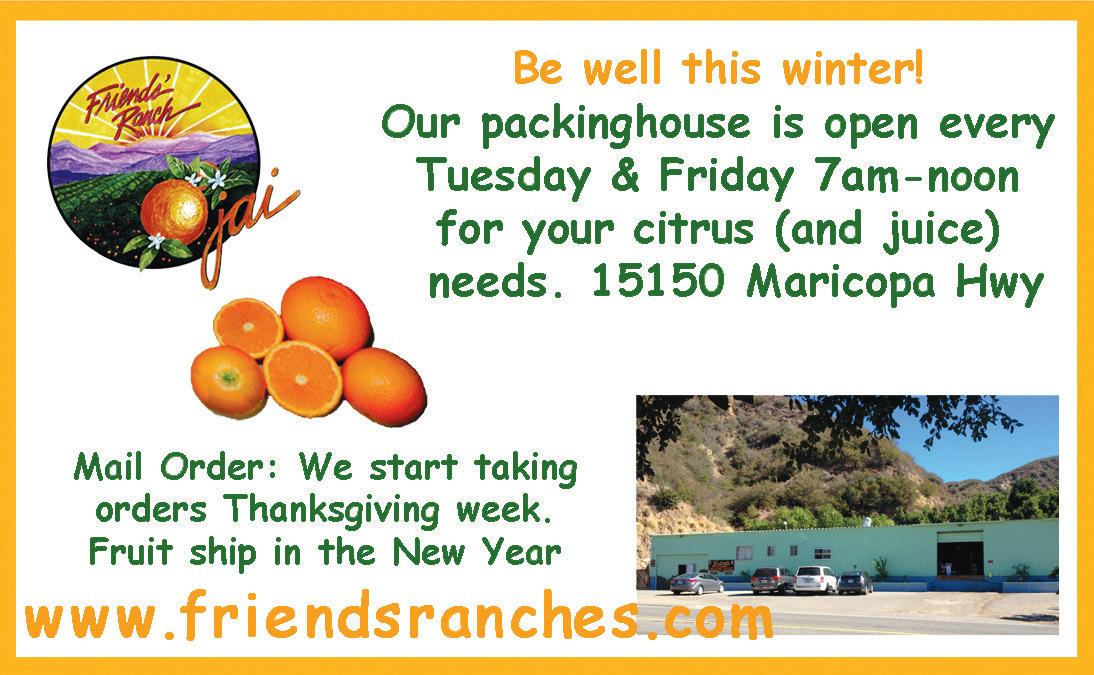


WINTER 2022/23 59 EdibleVenturaCounty.com Since 1984 JohnNicholsGallery.com Vintage, Vernacular and Contemporary Photographs Custom Archival Framing “Seed/Signal” by John Nichols 117 N. 10th St., Santa Paula Hours: By Appointment or by Chance Phone: 805-501-7011 Located above the Santa Paula Art Museum EMPLOYMENT COUNSEL & LITIGATION | INTELLECTUAL PROPERTY Innovative | Experienced | Responsive info@lightgablerlaw.com | LightGablerLaw.com | 805.248.7208 Ignoring employee issues doesn’t make them go away.
All Things Tea













European teahouse with certi ed Tea Specialist. Specialty loose-leaf teas from the nest plantations and gardens around the world. Cream Tea, Afternoon Tea and High Tea.
In Paseo Camarillo Center | 300 N. Lantana St., #37 | Camarillo | 805-445-8327 | Tea-Liteful.com
CONEJO VALLEY







Chocolatine French Café
An authentic French café established in 2004 in the heart of Thousand Oaks, the family-owned spot pleases daily with breakfast, lunch and afternoon snacks of homemade quiches, sandwiches, crepes, macarons, co ee drinks and more!












2955 Thousand Oaks Blvd. | Thousand Oaks | 805-557-0561 | ChocolatineFrenchCafe.com

Freda’s






Wood-Fired Pizza
Delicious NY-style and brick oven pizzas, sandwiches and salads. Dining, catering, pickup/ delivery—and with two mobile wood- red ovens, we can bring the party to you!
2024 Ventura Blvd., #114 | Camarillo | 805-586-4055 | FredasPizza.com
Coin & Candor at Four Seasons Westlake Village

A seasonally inspired California brasserie featuring sophisticated casual indoor and outdoor space with stunning views of the Santa Monica Mountains. The menu presents locally sourced dishes that incorporate wood- red cooking techniques.
2 Dole Dr. | Westlake Village | 818-575-3044 | CoinAndCandor.com
Onyx Bistro
Woman owned and operated, serving a casual but re ned seasonal menu made with locally sourced ingredients and paired with local craft beer and wine. Indoor and outdoor seating, live music on weekends, and brunch o ered Sundays. 2390 Las Posas Rd. Suite H | Camarillo 805-991-7356 | onyxbistrocamarillo.com
NABU Wines
A member of the Malibu Coast wine trail, NABU makes wine from Napa Valley to the Malibu Coast. Live music and wine tasting every Saturday & Sunday noon–6pm.
2649 Townsgate Rd. | Westlake Village | 818-835-3704 | NabuWines.com
60 WINTER 2022/23 Edible Ojai & Ventura County
Our pruning standards are proven to promote healthy growth, strong structure and pleasant aesthetics for all trees. With our help your fruit trees can have better tasting fruit and more of it! Edwin
Board Certified Master Arborist Pruning Fertilizing Planting and Removal Consultation Tree Risk Assessment Tree Maintenance (805)652-0404 TreecoVentura@att.net TreecoVentura.com 800-248-BUGS • 805-643-5407 • Ventura, CA rinconvitova.com Aphid Control Ant Control Fly Control edible ojai & ventura county Local Guide to Good Eats & Drinks To join the guide, contact us at ads@edibleventuracounty.com CAMARILLO
Slowik
OJAI
Bonito Coffee Roaster

Small-batch co ee roaster bringing generations of Nicaraguan craftsmanship to the Ojai Valley. Co ee roasted weekly. Visit by appointment.
406 Bryant Cir., Unit K | Ojai | 805-256-7873 | BonitoCo ee.com
VENTURA
Paradise Pantry

Food with a local emphasis, including great sandwiches, salads, mac ‘n’ cheese, gourmet goodies, a cheese counter and an extensive wine shop. Diners can also enjoy craft beers, wines by the glass or wine ights.
222 E. Main St. | Ventura | 805-641-9440 | ParadisePantry.com

The Wine Closet







Wine lounge in Old Town Camarillo, featuring unique wines, craft beers, small plates, lunch and dinner. Weekly happy hours and featured wine tastings. Indoor and outdoor seating. The specialty market o ers retail sales of ne wines, craft brews, artisan cheeses and charcuterie.


2423 Ventura Blvd. | Camarillo | 805-746-5708 | WineClosetInc.com
SIMI VALLEY
Nectar of the Dogs Wine



Brand new wine tasting room on the west end of Simi Valley. Wines sourced locally in California with a portion of sales donated to local nonpro t dog rescue organizations.


791 Chambers Ln. Suite 110 | Simi Valley 702-275-0482 | NectaroftheDogsWine.com
SANTA PAULA
Anna’s Ciders and Santa Paula Brewing Co.
Hard Cider Tasting Room in Downtown Santa Paula. Familyowned craft cider company producing dry & refreshing ciders. We serve food on our outdoor patio and are family friendly.
801 E. Main St. | Santa Paula | AnnasCider.com.

Poseidon Brewing Company



A small, local, veteran-owned craft brewery making a variety of beer styles. Visit the tasting room or take a growler to go.

5777 Olivas Park Dr., Ste. Q | Ventura | 805-477-0239 | PoseidonBrewingCo.com
NEWBURY PARK/OXNARD
Ragamuffin Coffee Roasters



Family owned and operated co ee shop and bakery with ethically sourced co ee, gluten-free pastries and excellent service.
111 N. Reino Rd. | Newbury Park 805-375-9000 | 550 Collection Blvd., Ste. 130 | Oxnard | 805-278-5837 | Ragamu nRoasters.com


CATERING


Private Chef Robin Robin Goldstein is a California chef who works her culinary magic combining unique avors and seasonal ingredients with classic techniques inspired by her extensive travel around the Mediterranean. PrivateChefRobin.com
FILLMORE
Roan Mills Bakery
California’s rst land-to-loaf bakery, Roan Mills grows the wheat, mills the our, bakes the bread and makes the pasta. Stop in at their bakery in historic downtown Fillmore and taste the di erence.
411 Central Ave. | Fillmore | RoanMills.com

Ventura Spirits
Since 2011, using the natural and agricultural bounty of California’s Central Coast to hand craft novel and delicious spirits.

3891 N. Ventura Ave. | Ventura | 805-232-4313 | VenturaSpirits.com
Tierra Sur at Herzog Wine Cellars
Ventura County’s highest rated restaurant, o ering 5-star dining at a stylish and modern winery. Discover nationally awarded local wines, exquisite cuisine, private tasting rooms and a gift boutique. Sunday brunch.
3201 Camino del Sol | Oxnard | 805-983-1560 | TierraSurAtHerzog.com
WINTER 2022/23 61 EdibleVenturaCounty.com
Please visit our advertisers and let them know you appreciate their support of Edible Ojai & Ventura County. They enable us to offer this magazine free of charge to readers throughout
Ventura County.



® certi edhumane.org
BITTER ABOUT COCKTAILS?
Measure out that dash for the best cocktail flavor
BY JOHN NICHOLS
Icame of age in 1966. I also entered a “cocktail desert” as the 1960s and ’70s seemed lost to fine drinking. Later, I became a book dealer and collected vintage books that delved into drink recipes from the 1920s and ’30s. With each new recipe I discovered, I collected the ingredients and raised the bar. Today I try to mix about three new and different cocktails each weekend.
Bitters—alcoholic infusions flavored with herbs and spices and generally sold in small bottles—are an essential ingredient in a lot of cocktails. Let’s begin with Angostura aromatic bitters in a Rye Manhattan. The classic recipe calls for a ratio of 1:3 with, for example, 1 ounce dry vermouth and 3 ounces rye whiskey, plus 2 dashes of Angostura bitters. This drink is stirred over ice and then strained into a chilled cocktail glass with a Maraschino cherry added for garnish.
I recently viewed this cocktail being made on YouTube and the mixologist just shook the bottle twice over the other ingredients. Does that mean that a shake of the bitters bottle is equivalent to a dash? NO! That little hole in the plastic cap of a bitters bottle is not the way to accurately measure out a dash.
The best way is to take the plastic lid off of the bottle and decant some bitters into a small eyedropper bottle. Then, use the eyedropper to carefully add 8 drops to the cocktail for each dash called for. Two dashes equal 16 drops. Don’t worry that adding this many drops is going to make your cocktail “bitter.” Bitters work like salt added to soup and really enhance the overall flavor of the cocktail in a subtle way. Too small a portion of bitters, like what comes out of the bottle when you just give it a shake, does not have the desired effect.
I recommend that you ditch the bitters bottle and perforated cap and move on over to eyedropper bottles for each of your bitters. Now, try this next cocktail with the proper quantity of orange bitters.

e Martini: I like the ratio of 1:6 of dry vermouth to gin with 2 dashes of orange bitters. I add ½ ounce of dry vermouth to 3 ounces gin with 16 drops of orange bitters. I stir the ingredients over ice for 65 rotations and then strain into a chilled cocktail glass. I garnish with a lemon peel if available and avoid those salty olives at all costs.
in 1984, specializing in vintage and contemporary photographs, archival framing and curatorial services. He has judged cookies at the Ventura County Fair for 30 years and has been the director of the Ag Art Alliance since 2007. To learn more, visit JohnNicholsGallery.com.

WINTER 2022/23 63 EdibleVenturaCounty.com
COCKTAIL Hour
John Nichols of Santa Paula opened John Nichols Gallery
The Ventura Sun ower
BY GRAHAM HARRIS | PHOTO BY VIKTOR BUDNIK
The goal was to create a cocktail that really highlights the abundance around us in Ventura County. We are surrounded by beautiful citrus, fragrant herbs, gorgeous flowers and great local producers like Ventura Spirits. With that in mind, the flavor profile was focused on showcasing each of the individual ingredients, while also delivering a balanced experience on the palate. In this drink, the citrus and aromas of Amaro Angeleno hit you first, and then as you drink it the elderflower liqueur and spice and citrus notes from the Wilder Gin really pop, while the back end of curacao rounds out the drink to create a smooth finish. Perfect for a warm day in Ventura County, of which we have many.
1 ounce Ventura Spirits Wilder Gin
1 ounce fresh-pressed lemon juice
1 ounce St-Germain elderflower liqueur
½ ounce Ventura Spirits Amaro Angeleno ½ ounce Curacao
In a cocktail shaker, combine all ingredients with ice. Shake well, strain and serve up in a coupe glass with local edible flower garnish.
This drink is on the menu at Decker Kitchen and other participating venues as the Venturan or the 22 Venturan.

LAST Sip
Winner of the 2022 Taste of Local Mixology Throwdown!
64 WINTER 2022/23
Edible Ojai & Ventura County
Get fresh updates on our work to ensure the future of agriculture includes all Americans.

farmland.org
Discrimination against marginalized groups in agriculture negatively affects all Americans by limiting the opportunities for farmers, workers, and consumers. AFT is raising up diverse voices in agriculture, because we believe diversity contributes to a more resilient agricultural system, a stronger economy, and a more equitable society.

WINTER 2022/23 65 EdibleVenturaCounty.com
At American Farmland Trust, we believe agriculture is strengthened through diversity, just like the soil.



































































































































































































































 BY JENNIFER RICHARDSON
BY JENNIFER RICHARDSON
 Photos courtesy of Rodale Institute
Photos courtesy of Rodale Institute















 WORDS AND PHOTOS BY AVERY LIEB
WORDS AND PHOTOS BY AVERY LIEB



 By Avery Lieb
By Avery Lieb











































































































































































 PHOTOS STYLED AND RECIPES BY ROBIN GOLDSTEIN
PHOTOS STYLED AND RECIPES BY ROBIN GOLDSTEIN















































































































